Balcony plants: 23 picks for pocket-sized growing spaces
Choose easy-to-care for balcony plants for a low-maintenance plant paradise. Here are the top choices for sun, shade and windy spots
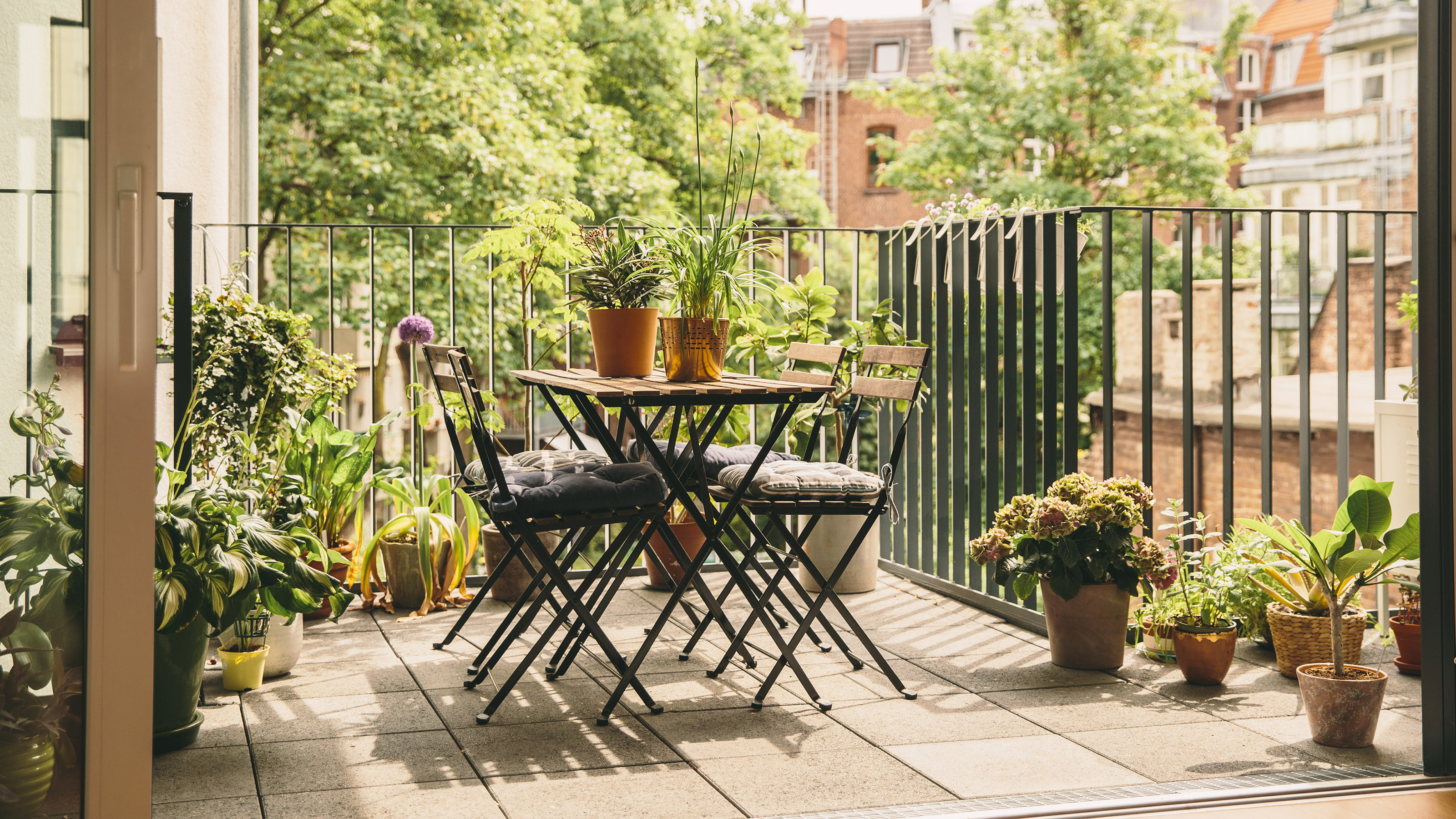

The key to transforming your balcony into a mini oasis is to select balcony plants that are right for your growing conditions. No two balconies are the same. So before you set foot into a garden center, carry out an assessment. Is your space exposed or sheltered? Sunny or shady? Or perhaps something in between.
Our plant guide will help you decide which varieties best suit your balcony’s conditions. If you're interested in bringing in some large structural plants, it’s also important to check with the building owner, or a structural engineer what weight your balcony can take.
If thinking about balcony garden ideas is a new venture for you, start small. Get a couple of plants and a couple of pots. The chances are the more time you spend on the balcony, the more you’ll fall in love with gardening!
Pack containers with beautiful balcony plants for a pocket-sized oasis
With the right choice of balcony plants and container gardening ideas, there's absolutely no reason why your small garden can't be just as foliage-rich and flower-filled as some much bigger gardens. It's all about choosing the varieties which will thrive in your particular spot.
1. Santolina
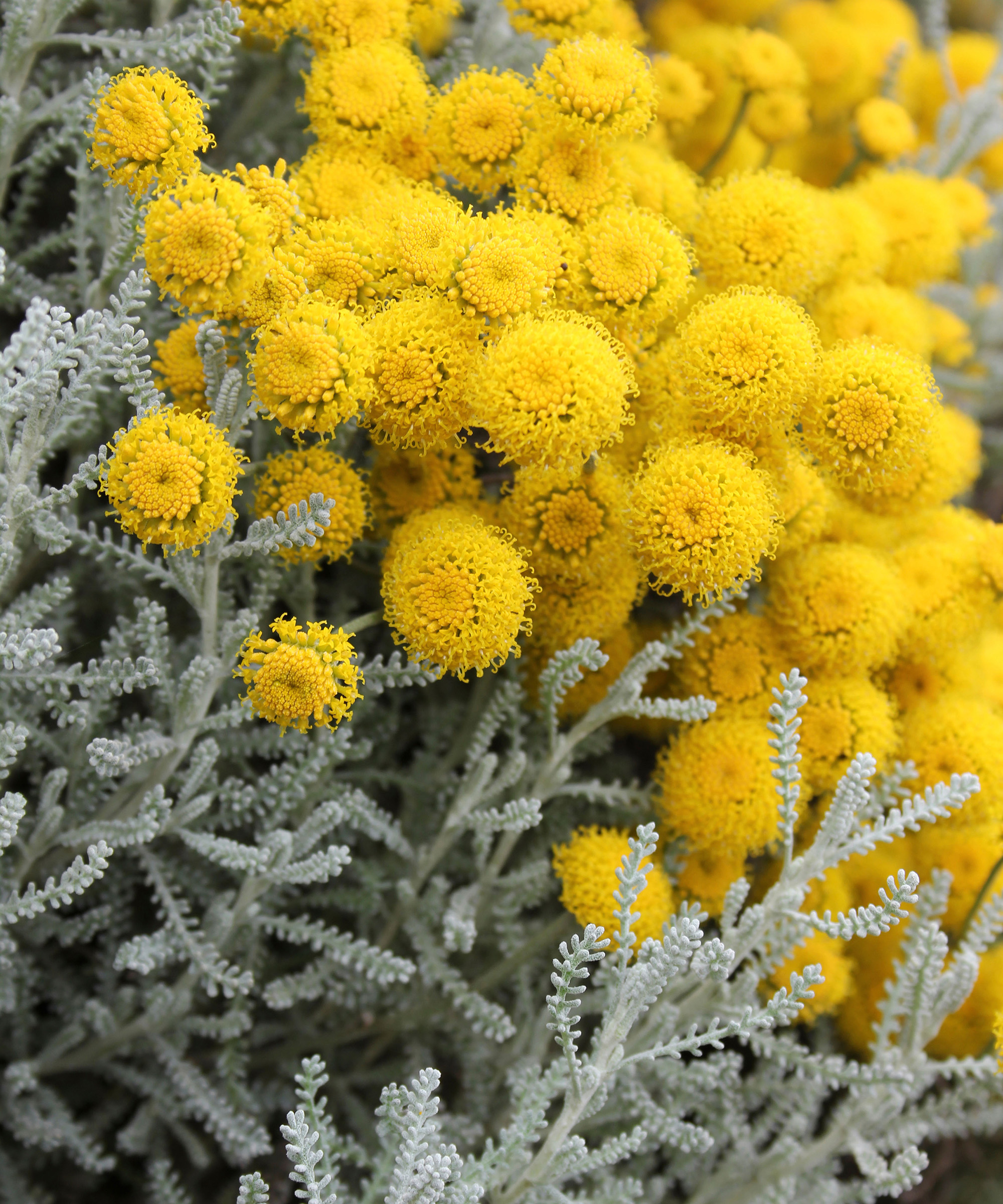
Cotton Lavender (Santolina chamaecyparissus)
- Hardiness: USDA 7-8 (UK H5)
- Height: 19in (50cm)
- Spread: 3ft 3in (1m)
- Best for: Sunny window boxes
Cotton lavender’s compact size and rounded habit makes it a good choice for window box ideas on balconies, where space is typically at a premium. Most varieties have aromatic, silvery foliage complemented by yellow button flowers in summer, but S.rosmarinfolia offers mid-green foliage.
In early spring, clip them back to where the new growth starts, and cut the faded flower heads off in fall. ‘Pretty Carol’ and ‘Primrose Gem’ are among the most attractive varieties for balcony plants.
2. Jasmine
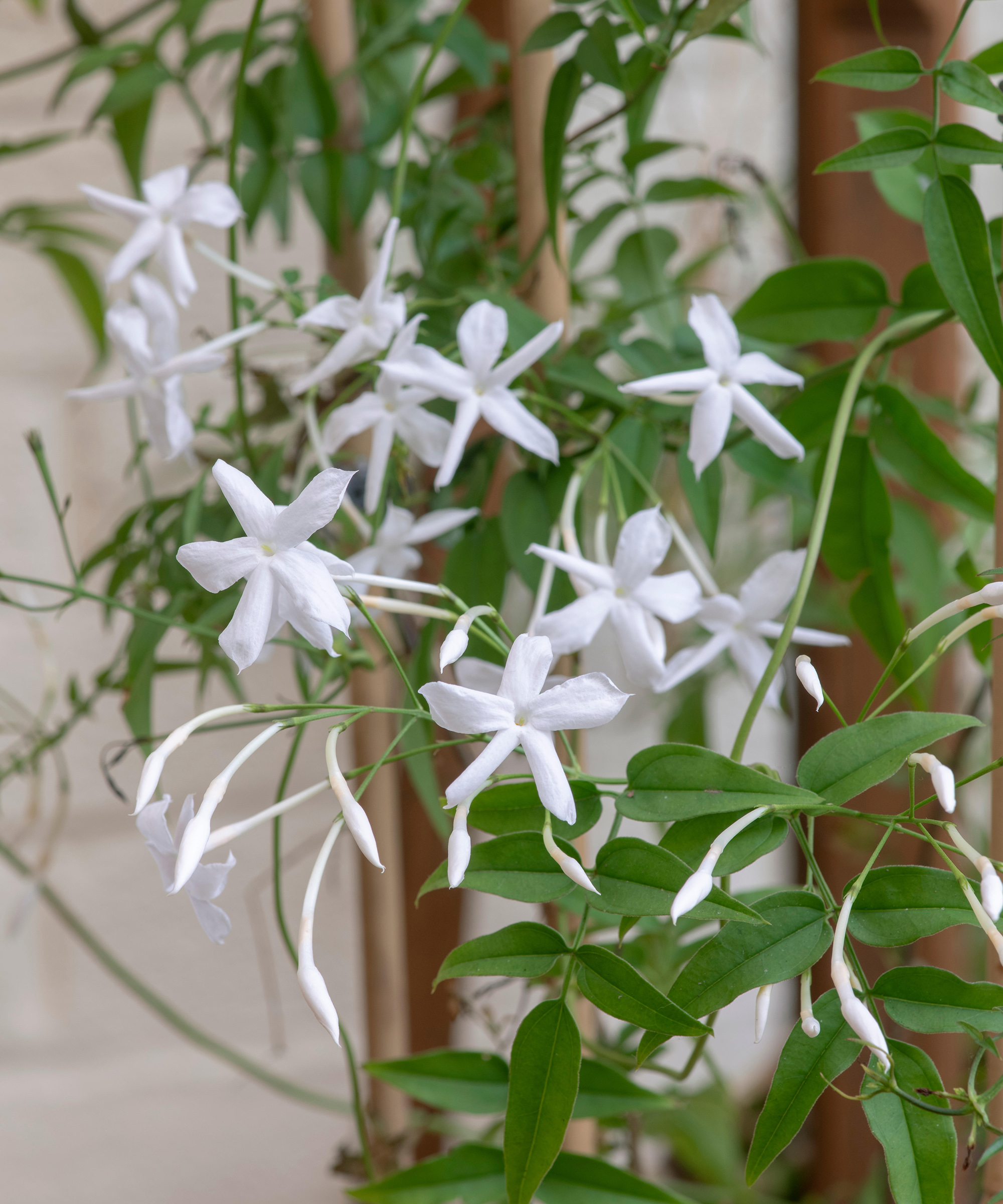
Jasminum ‘Devon Cream’
- Hardiness: USDA 8-9 (UK H4)
- Height: 9ft 8in (3m)
- Spread: 9ft 8in (3m)
- Best for: Sun and scent
This summer-flowering beauty from the Mediterranean will fill your balcony with scent. So you can sit back and dream of faraway places. They’re hungry plants, so use a rich compost like John Innes No3, and line the bottom of the container with a sheet of newspaper to help to retain moisture and nutrients.
Position the garden planter in a sheltered corner, and train the long stems along the balcony railings. Jasminum ‘Devon Cream’ (above) has gorgeous cream-colored flowers. Feed with tomato fertilizer monthly in summer.
3. Zinnia elegans ‘Queen Red Lime’
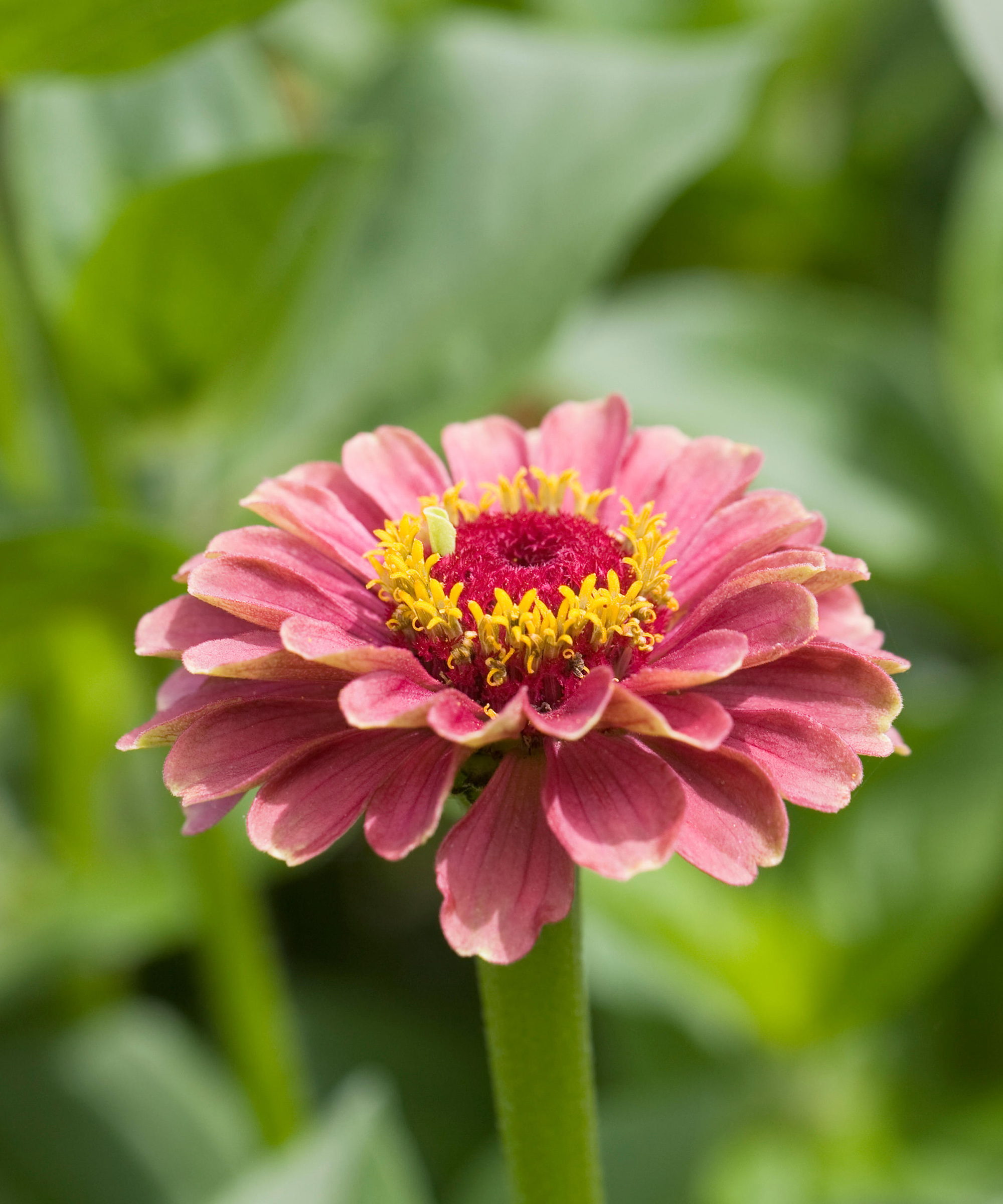
Zinnia elegans 'Queen Red Lime' flower
- Hardiness: USDA 9-10 (UK H3)
- Height: 3ft 3 in (1m)
- Spread: 1ft 6in (50cm)
- Best for: Sunny color
These fun, half-hardy annuals that are native to Mexico are easy to grow and their vibrant blooms really pop against a backdrop of greenery. If you water and feed them regularly with tomato plant food they’ll give you blooms from summer to the first frosts.
Buy large plug plants in early summer and they’ll be ready for immediate planting into containers. They'll make some of the best plants for window boxes, although shorter varieties will fare better on windy balconies.
‘Queen Red Lime’ (above) has unusual red petal tipped with lime-green and will reach to over 3ft. ‘Zahara Mixed’ is shorter at 15in (40cm) and won’t need staking.
4. Pelargoniums
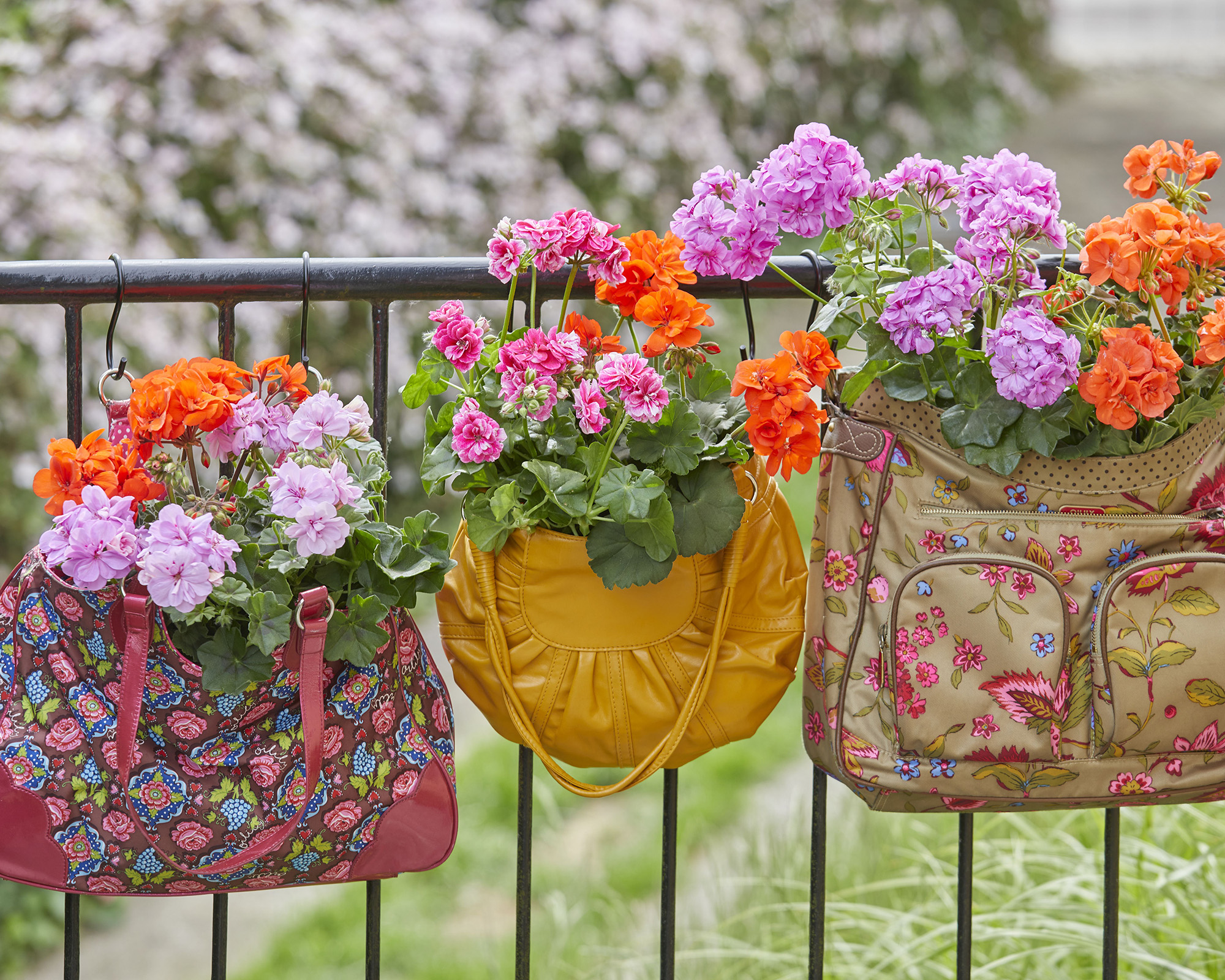
Make use of the railings of your balcony for plants
- Hardiness: USDA 9-10 (UK H3)
- Height: 18in (45cmm)
- Spread: 1ft 6in (50cm)
- Best for: Sun, low maintenance
There’s a reason why you’ll see pelargoniums – sometimes referred to as tender geraniums – on balconies and walls in countries like Spain and Morocco. They cope well in hot, dry conditions, and they look stunning too!
The scented foliage varieties give extra interest – ‘Attar of Roses’ is one of the best for this. Trailing types are great for growing over the side of balconies, while upright varieties look good grouped together in similar shades.
Water and feed them regularly in summer, and deadheading flowers which are spent means plants will keep pumping out flowers until the end of fall.
5. Lavender
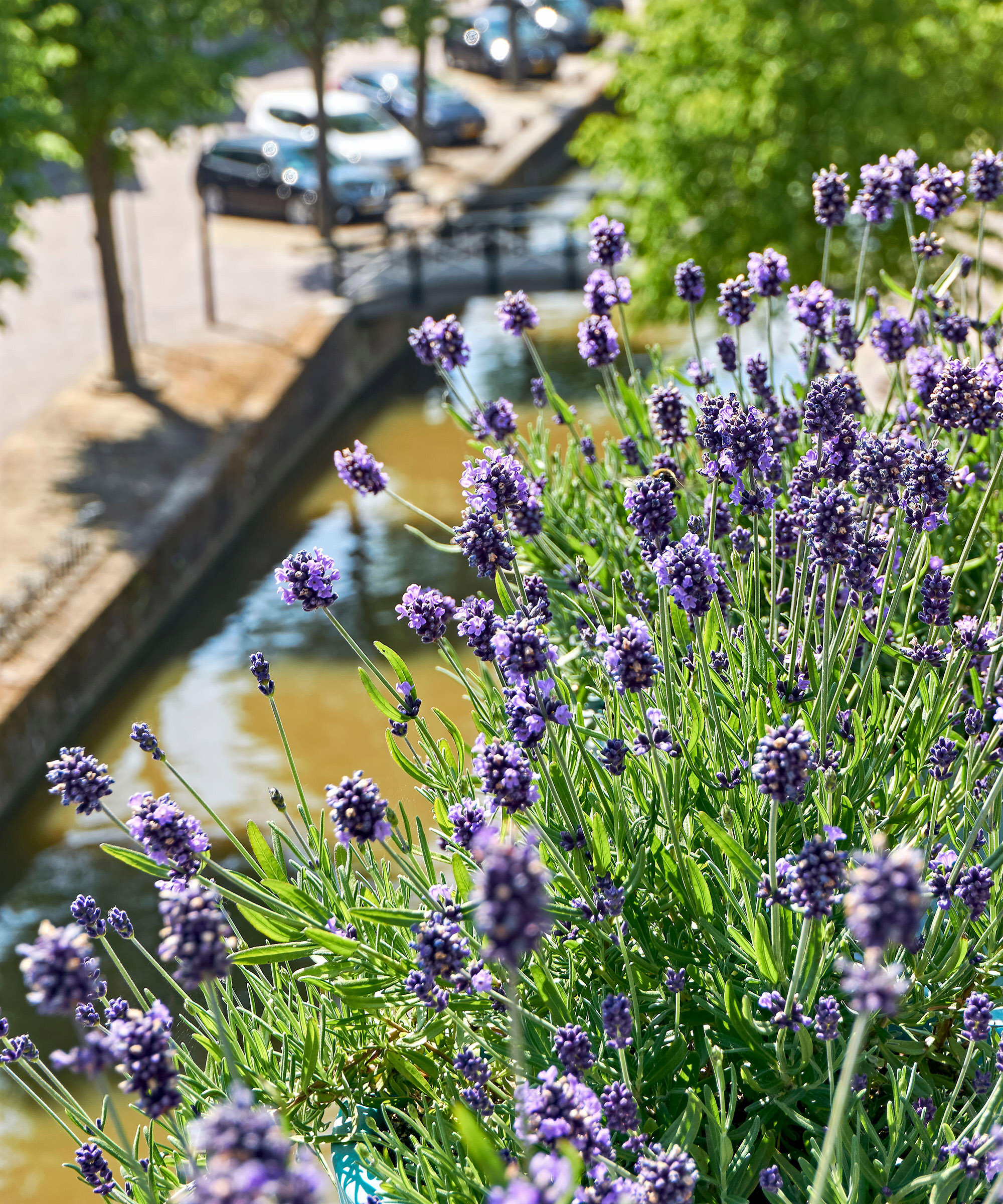
Tender French lavender
- Hardiness: USDA 7-8 (UK H5)
- Height: 2ft (60cm)
- Spread: 2ft 5in (75cm)
- Best for: Drought and wind tolerance
This drought and wind tolerant evergreen from the Mediterranean is a super balcony bloomer. Its aromatic silvery foliage is always a crowd pleaser, and a compact growing habit makes it perfect for planters and containers, meaning you can still enjoy landscaping with lavender when you're short on growing space.
English lavender (L.angustifolia) is the hardiest and has the longest lasting blooms. The French lavender L.stoechas is smaller and more tender but with fatter flowerheads.
Use containers with drainage holes in the bottom and fill with a John Innes no3 compost. In fall, prune lavender back to an inch or so above where the foliage begins – this is important as it will keep plants bushy for the following season.
6. Sun-loving grasses
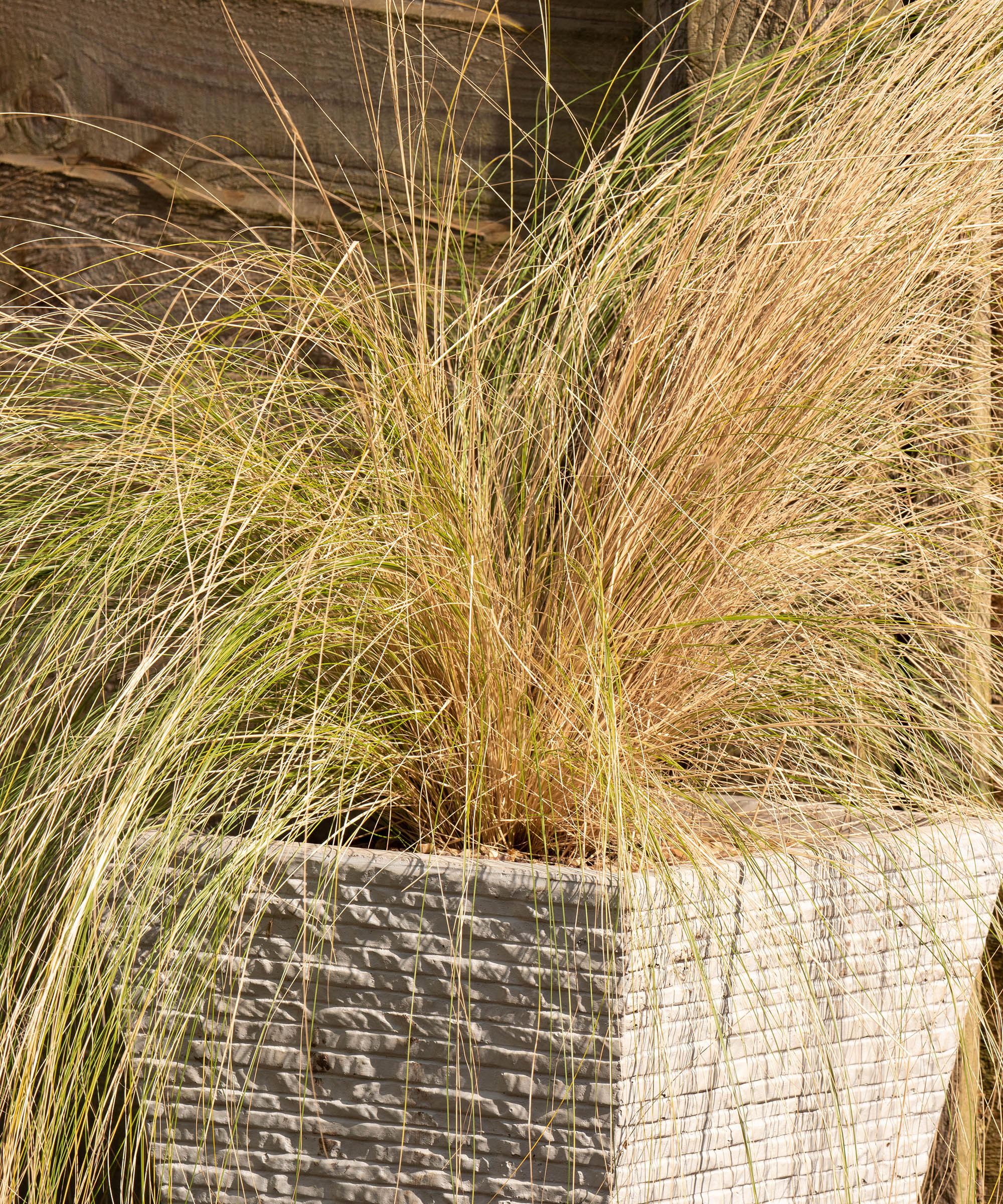
Feather Grass (Stipa tenuissima)
- Hardiness: USDA 7-8 (UK H5)
- Height: 2-3ft (60-90cm)
- Spread: 2-3ft (60-90cm)
- Best for: Windy, sunny spots
These low-maintenance plants offer a textural contrast to mounded evergreens like lavender and santolina. For a stylish coastal or contemporary look, try landscaping with grasses like Stipa tenuissima planted with eryngium (sea holly) and Oenothera lindheimeri. This look will be further enhanced alongside sleek wooden decking and planters.
Miscanthus ‘Starlight’ has elegant arching mid-green leaves and striking flower plumes that look good well into winter. In a raised planter, it would make a good windbreak for your balcony. Blue oat grass (Helictotrichon sempervirens) looks great in silver pots with its steely blue evergreen leaves and straw-colored plumes.
7. Armeria maritima
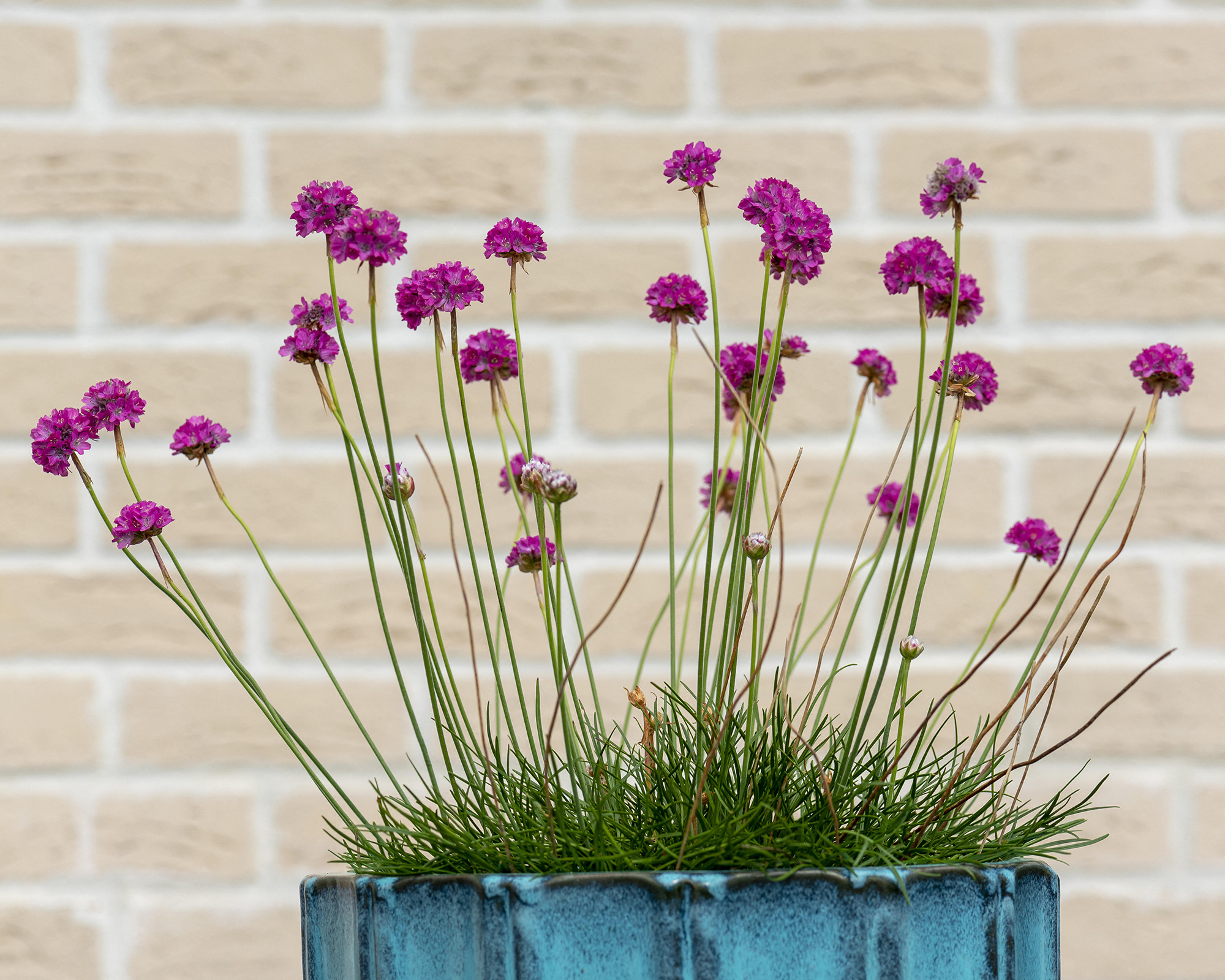
Thrift seapink (Armeria maritima)
- Hardiness: USDA 7-8 (UK H5)
- Height: 1ft 6in (50cm)
- Spread: 1ft 6in (50cm)
- Best for: pollinators
Armeria maritima - also known as Sea thrift - grows on coastal clifftops, so it’s great option for windy, sky-scraping balconies. Its low-growing evergreen tufts add texture and structure all year round, and the pretty cup-shaped pink or white flowers that emerge on long stems each spring, make eye-catching displays.
The flowers are rich in nectar and pollen and will attract bees and other pollinators. Grow as many as your space will allow for maximum impact. Position these plants for pollinators at the front of larger container displays or mingle with low-growing grasses.
You could add a crushed seashell mulch to help retain moisture and give a seaside vibe too.
8. Hebes
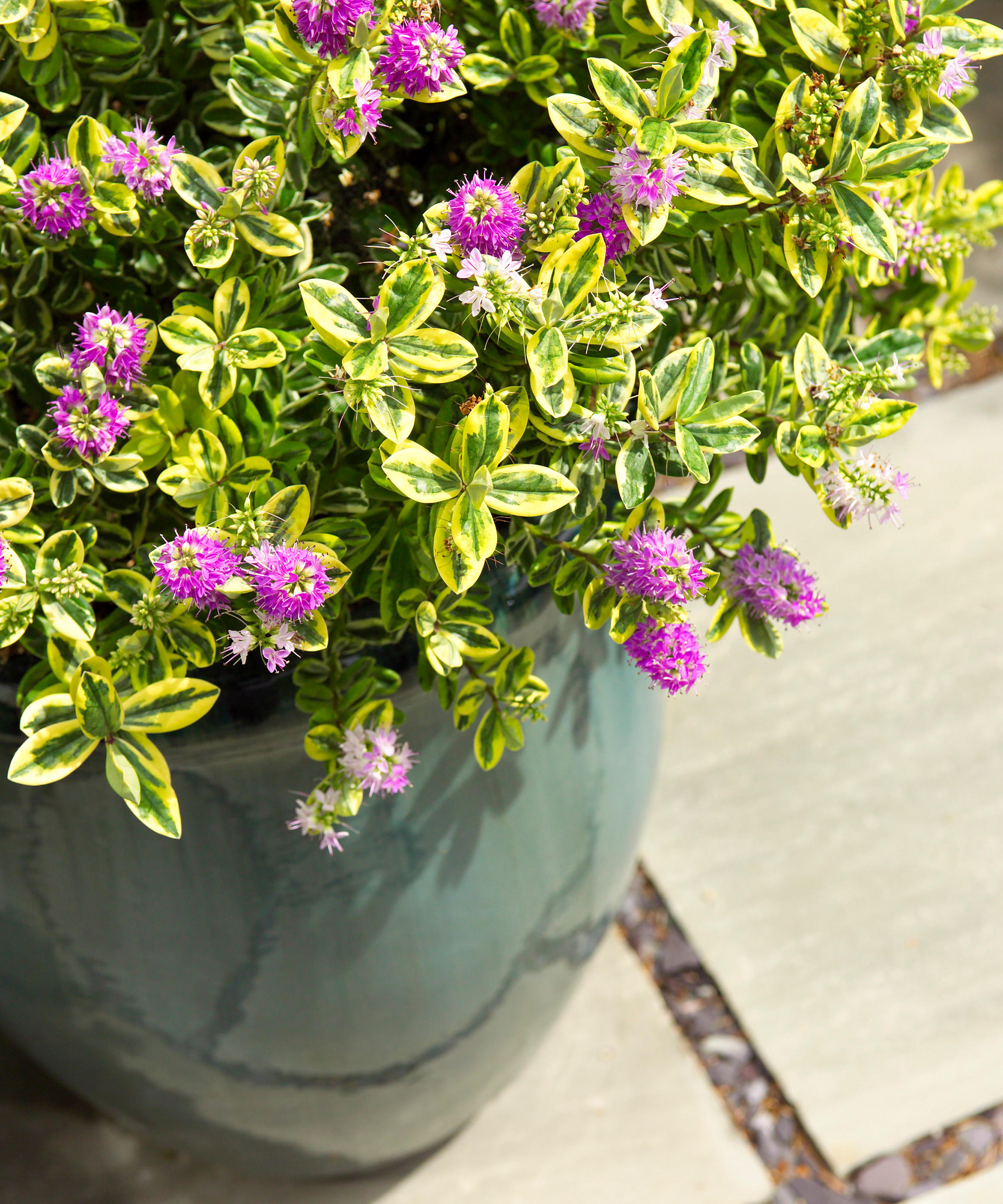
Variegated hebe
- Hardiness: USDA 8-9 (UK H4)
- Height: 1-4ft (30cm-1.2m)
- Spread: 1-4ft (30cm-1.2m)
- Best for: Wind and drought
Not only do the smaller-leaved hebes make excellent balcony plants, they’re among the easiest plants to care for. Their tough, leathery leaves cope well with wind and drought, and they naturally look like they’ve been clipped meaning you don’t have to bother getting the best secateurs out!
Happily, they don’t require much watering or feeding – in fact feeding them will make the foliage too lush and floppy. Hebe rakaiensis has clusters of large white flowers in early summer. Whilst ‘Heartbreaker’ has slender, variegated leaves that turn pink during the colder months.
9. Dwarf pines
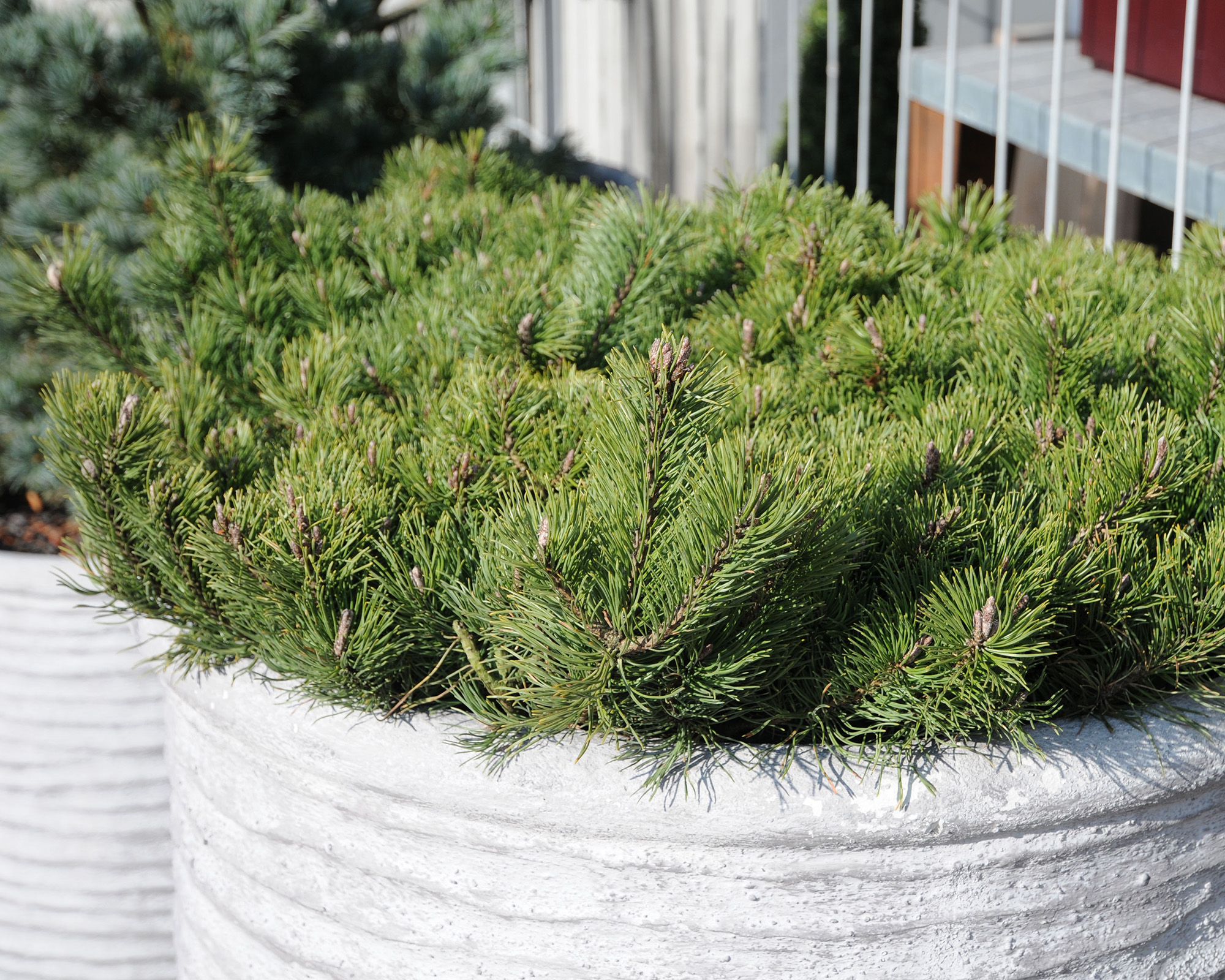
Pinus mugo
- Hardiness: USDA 2-7 (UK H7)
- Height: 3ft 2in (1m)
- Spread: 1ft 6in (50cm)
- Best for: Cold regions
These tough evergreen plants will add big personality to a sunny balcony without taking over the space. Unlike their full-sized versions, most dwarf varieties are slow-growing or reach a small size in maturity, making them perfect for growing in pots.
They’re super hardy too, coping with temperatures below -4˚F (-20˚C). Pinus mugo – or the dwarf mountain pine – has a compact rounded shape and is a good contrast for ornamental grasses like stipa and miscanthus.
‘Winter Gold’ has golden needles, ideal for brightening up a winter balcony. While ‘Mops’ has glossy dark green needles. As with all long-term planting displays in pots, use a loam-based John Innes No3 compost.
10. Campanula
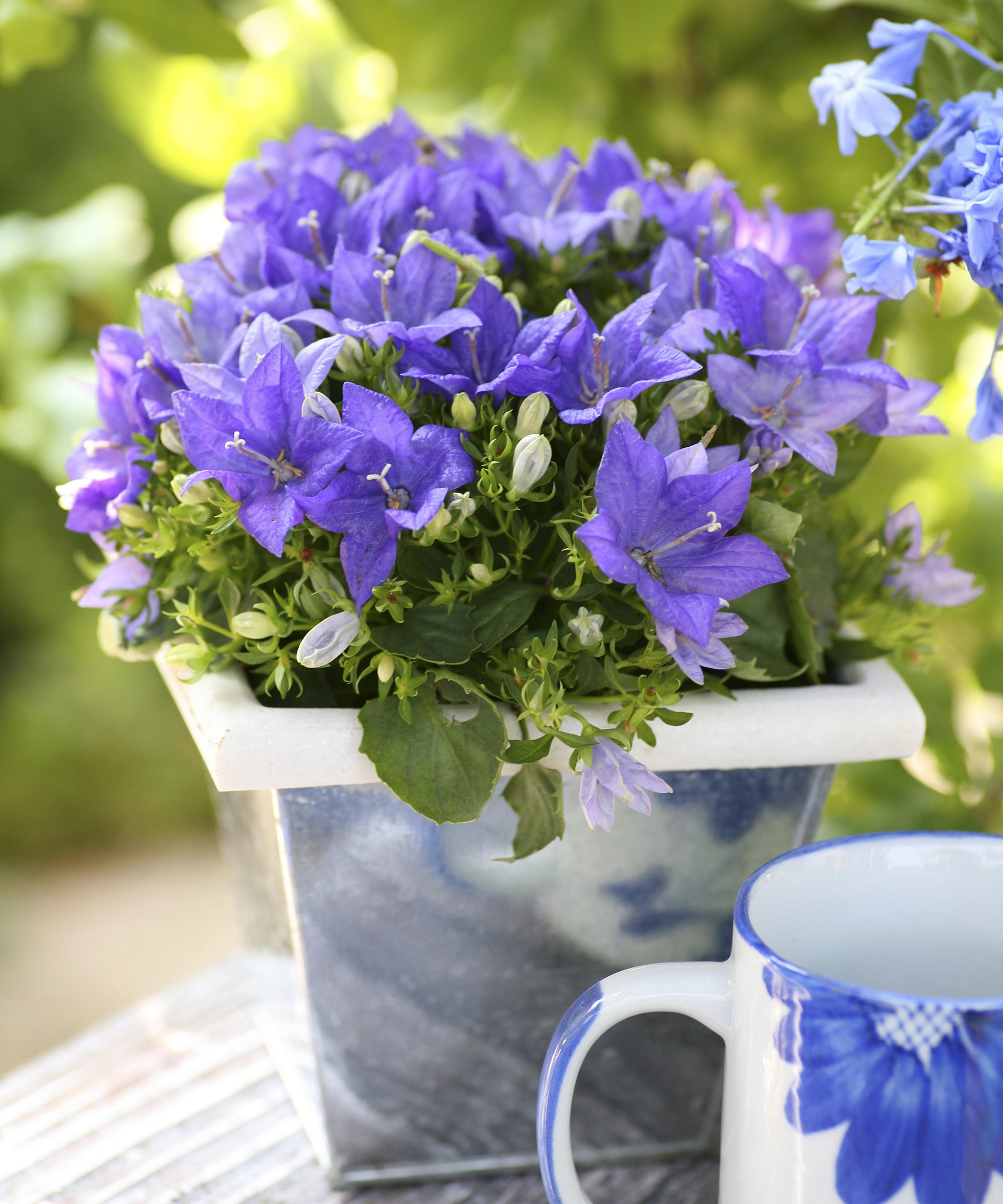
Campanula carpatica
- Hardiness: USDA 7-8 (UK H5)
- Height: 4-6in (10-20cm)
- Spread: 1-2ft (30-60cm)
- Best for: Clusters of blooms
These cottage garden plants are tougher than they look, particularly the low growing varieties like C.carpatica and C.portenschlagiana. They require little attention and will tolerate a lack of nutrients and water, as well as cope with partial shade.
A relatively new compact variety is ‘Porto’. It has neat foliage with petite purple bell flowers, and is great in small window boxes. It will flower on and off all spring and summer if kept well-watered.
Campanula glomerata has lollipop clusters of rich-purple blooms on stems. Cut back after flowering to prevent self-seeding and to encourage more blooms.
11. Hardy ferns
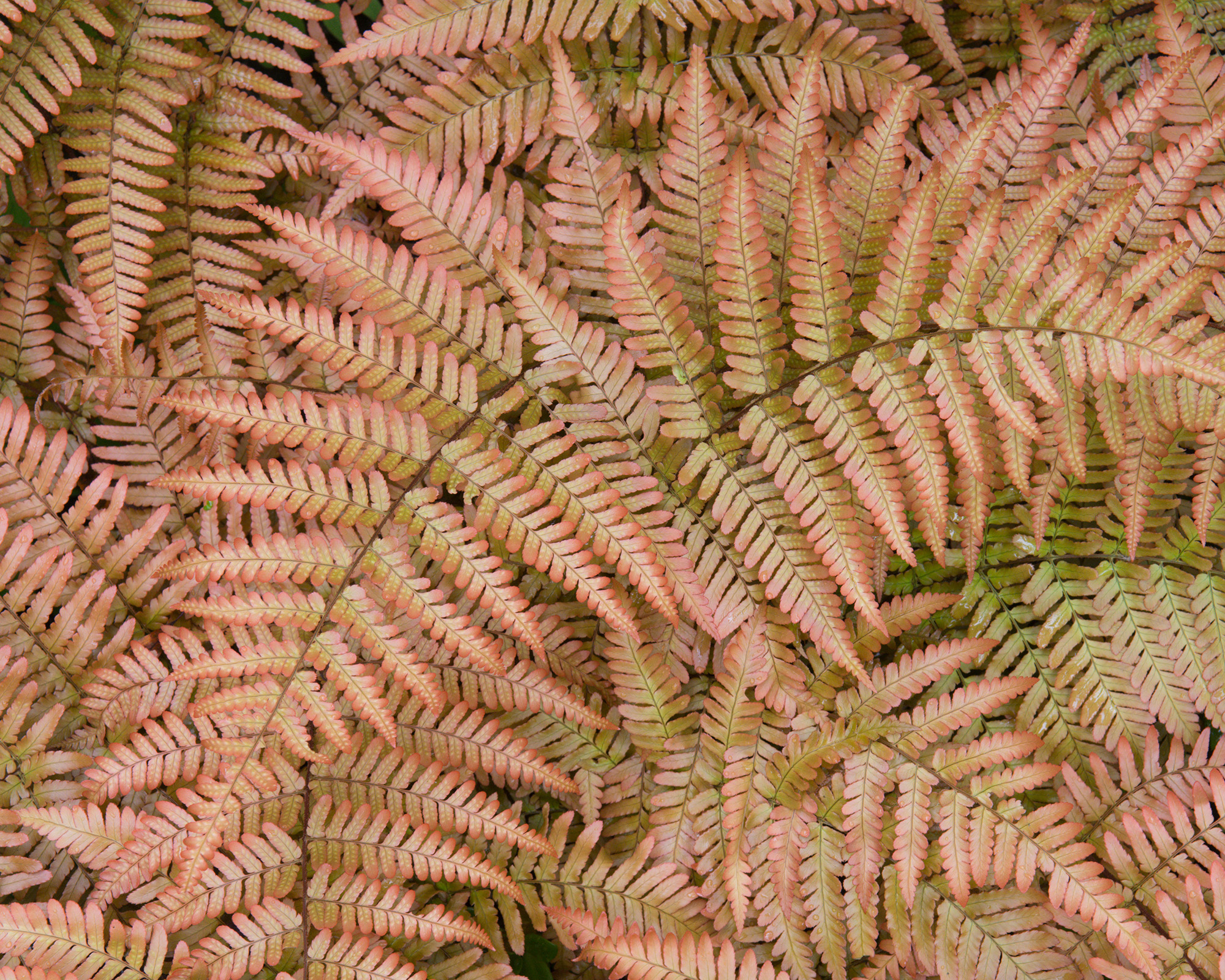
Copper shield fern (Dryopteris erythrosora)
- Hardiness: USDA 8-9 (UK H4)
- Height: 1ft 6in (50cm)
- Spread: 1ft 6in (50cm)
- Best for: Shady foliage
Ferns have a striking, architectural quality to them that makes them good enough to grow on their own. Perfect if you prefer the minimalist look or don’t want to spend too much time tending lots of different plants.
Grow ferns in taller pots so that you can better admire their graceful, arching fronds, closer to eye level. They don’t have a very deep roots though, so you can stuff the bottom of the pot with broken up bits of polystyrene, which will reduce the weight of the compost.
Dryopteris varieties cope well with drought conditions so do well in pots. D.erythrosora has lovely bronze fronds in spring deepening to mid green in summer. Hydrangea arborescens ‘Runaway Bride’ makes an excellent partner in a neighboring pot.
12. Salad leaves
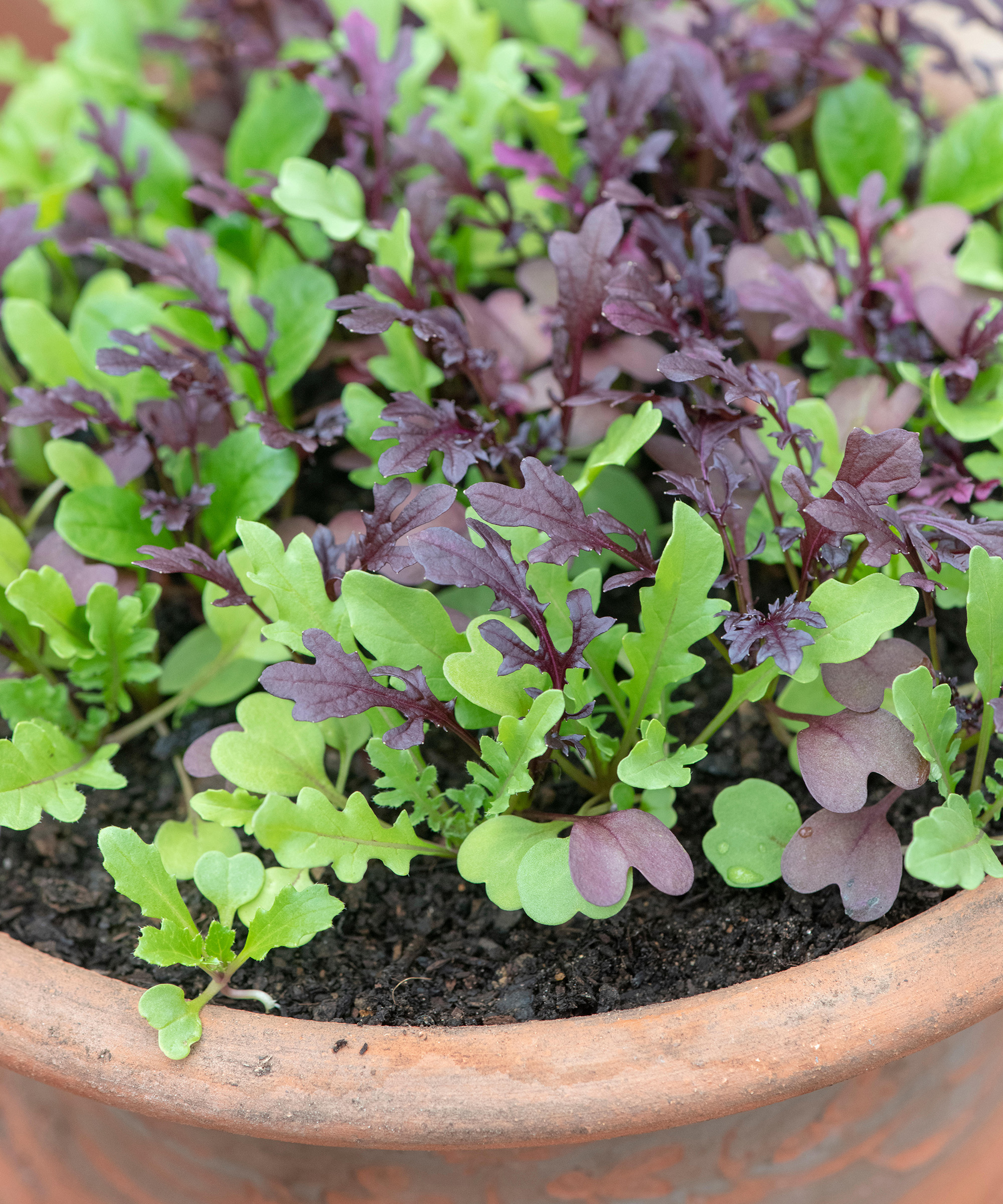
Salad leaves make great balcony veg
- Hardiness: varies
- Height: varies
- Spread: varies
- Best for: edibles
If there’s a shady nook on your balcony, and you're keen on growing vegetables in pots, why not grow your own tasty salad leaves? Lettuces, mustard leaf, radish and spinach prefer a cooler environment away from direct sunshine, and they won’t be bothered by slugs high up.
Choose window boxes or pots that are at least 5-7in (15-20cm) deep so plants can develop a decent root system. Make sure there are drainage holes and put a drip tray underneath, water from the bottom up. Use John Innes no2 peat free compost.
For baby leaves, plant the seeds 1-3in (5-10cm) apart, and for whole lettuce heads like ‘Little Gem’, plant 9in (25cm apart). Leaves will be ready to harvest in six to eight weeks.
13. Acer
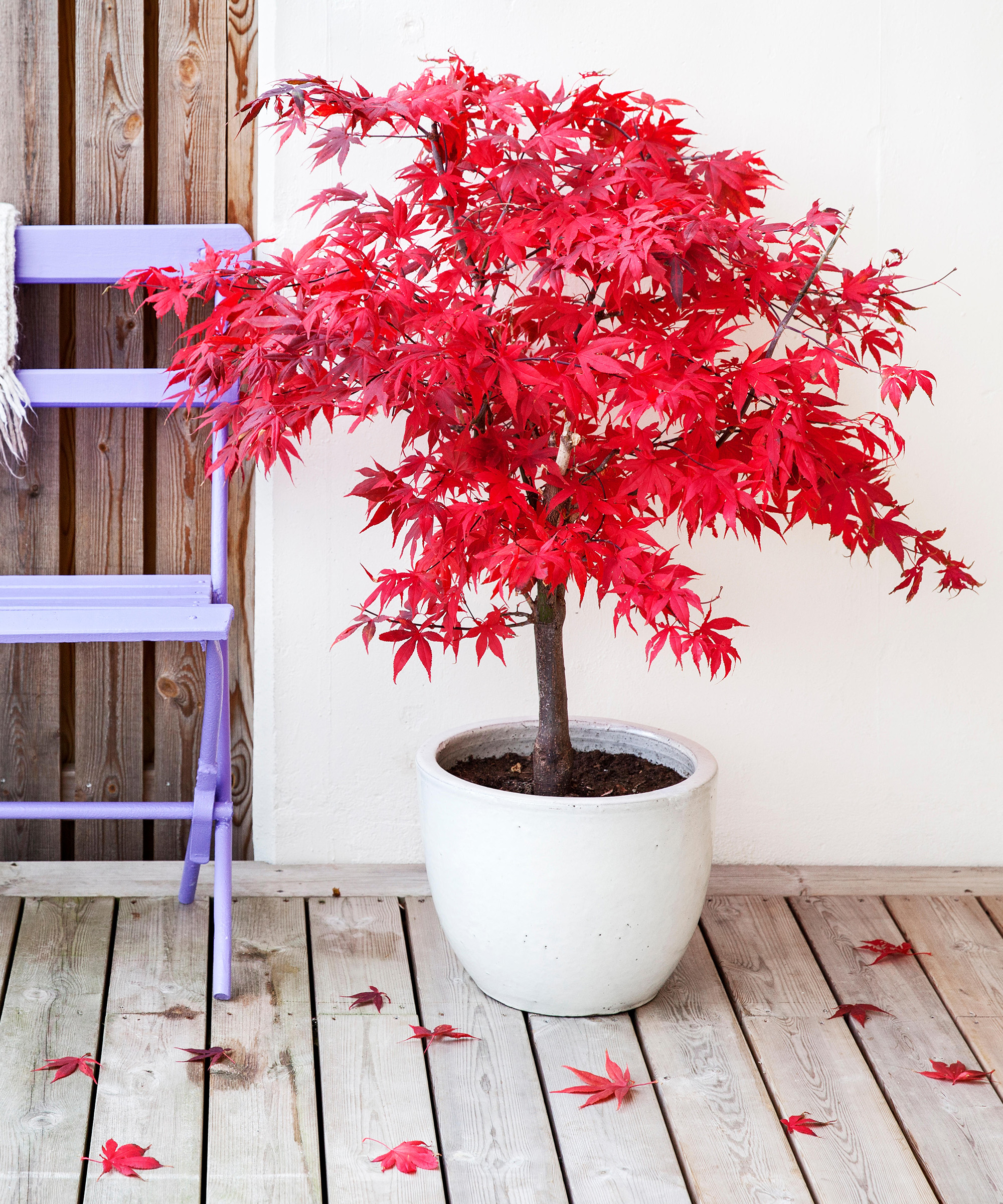
Japanese maple (acer palmatum)
- Hardiness: USDA 7-8 (UK H5)
- Height: 6ft 6in (2m)
- Spread: 6ft 6in (2m)
- Best for: Leaf color and texture
Many types of Japanese maples are ideal for pots as they are slow growing and make stunning focal points. They come in dozens of beautiful colors and leaf shapes. ‘Going Green’ has luminous green leaves in spring and summer, turning lovely shades in autumn.
They’re hardy but do best in a sheltered spot that’s not too windy and they're happy in shade. Get them off to a good start by creating your own potting mix using equal measure of John Innes No3, ericaceous (acidic) compost, and sharp sand for drainage.
They like their roots quite shallow, so plant the rootball just slightly proud of the top of the compost. Feed in spring and summer with a slow-release fertilizer or liquid feed. Keep the compost moist but not soaking wet.
14. Erysimum ‘Bowles’ Mauve’
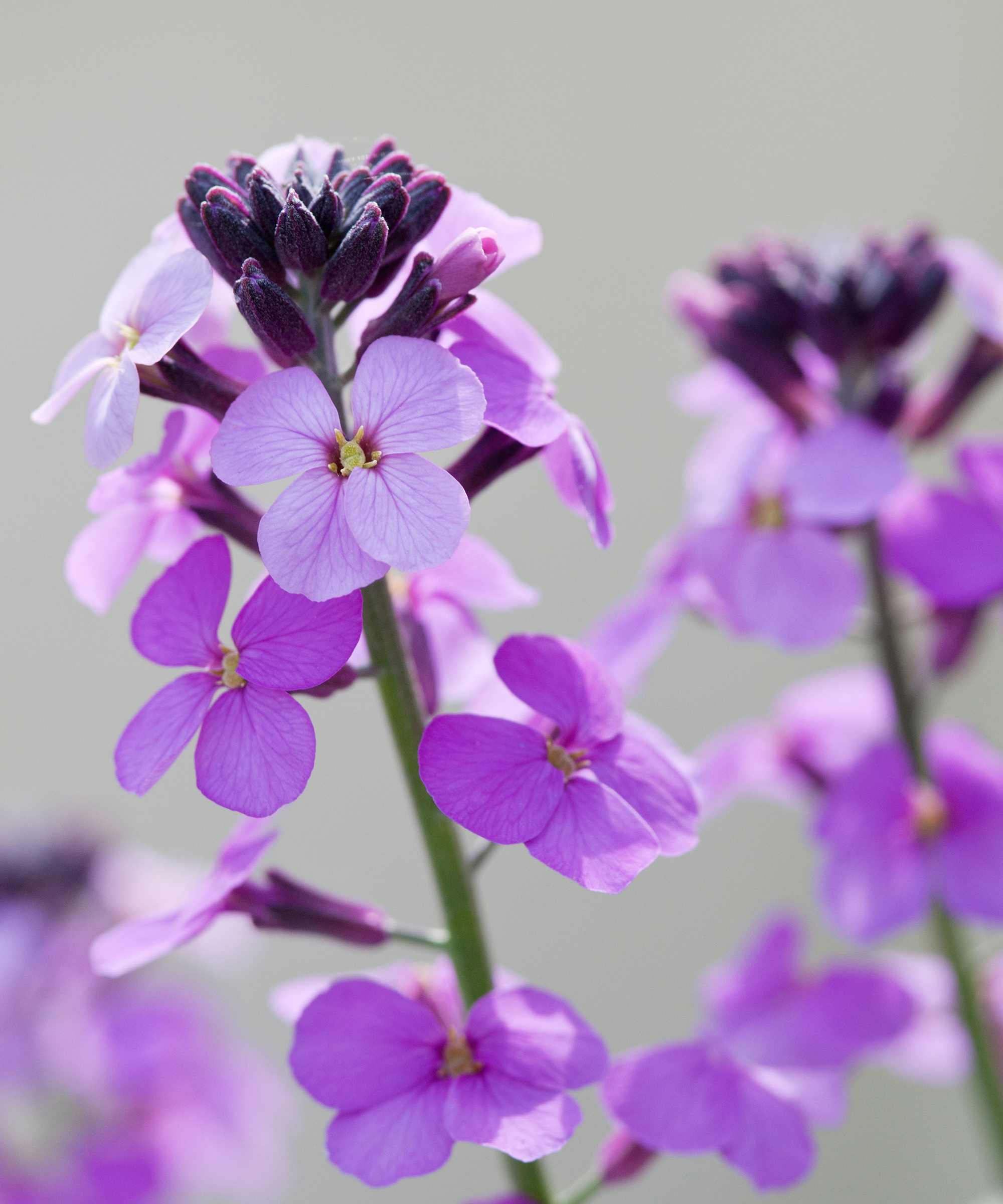
Erysimum 'Bowles Mauve'
- Hardiness: USDA 8-9 (UK H4)
- Height: 15in (45cm)
- Spread: 19in (50cm)
- Best for: Full sun
This wonderful wallflower produces elegant spikes of deep mauve flowers above narrow gray-green leaves, from early spring until the end of summer. You could feed it with a high-potash fertilizer in summer to keep the flowers looking good, but it will cope with poorer soil.
Trim plants lightly after flowering to help prevent legginess, but plants may need replacing after around four years. Wallflowers are sun-seekers but will tolerate some shade throughout the day. It's also a great bee-friendly plant.
15. Daisies
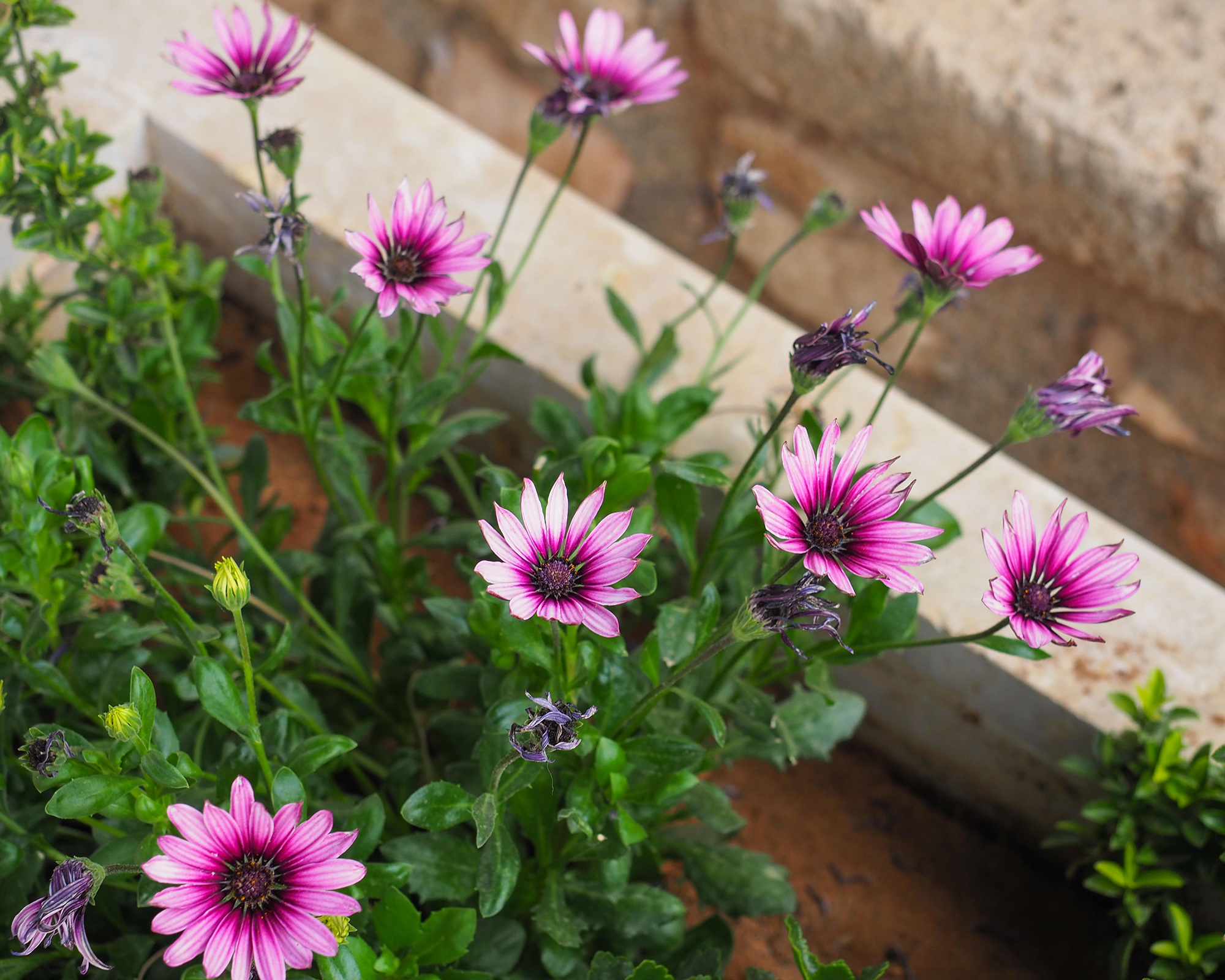
Osteospermum fruticosum
- Hardiness: varies
- Height: varies
- Spread: varies
- Best for: pollinators
Not only are they good looking, daisy plants are happy in sunny, dry and windy conditions. They’re also a magnet to bees and butterflies. On a balcony, naturally low-growing varieties like osteospermum and gazania are great, but taller shasta daisies (Leucanthemum x superbum) have strong flexible stems and will cope with windy conditions.
Brachyscome ‘Blue and white mix’ has a great froth of blue and white daisy flowers all summer long and looks good with other summer bedding plants like geraniums and calibrachoa. Erigeron is also a hazy daisy flower, with pink and white flowers all through summer. Check individual plant labels for hardiness rating.
16. Oenothera lindheimeri
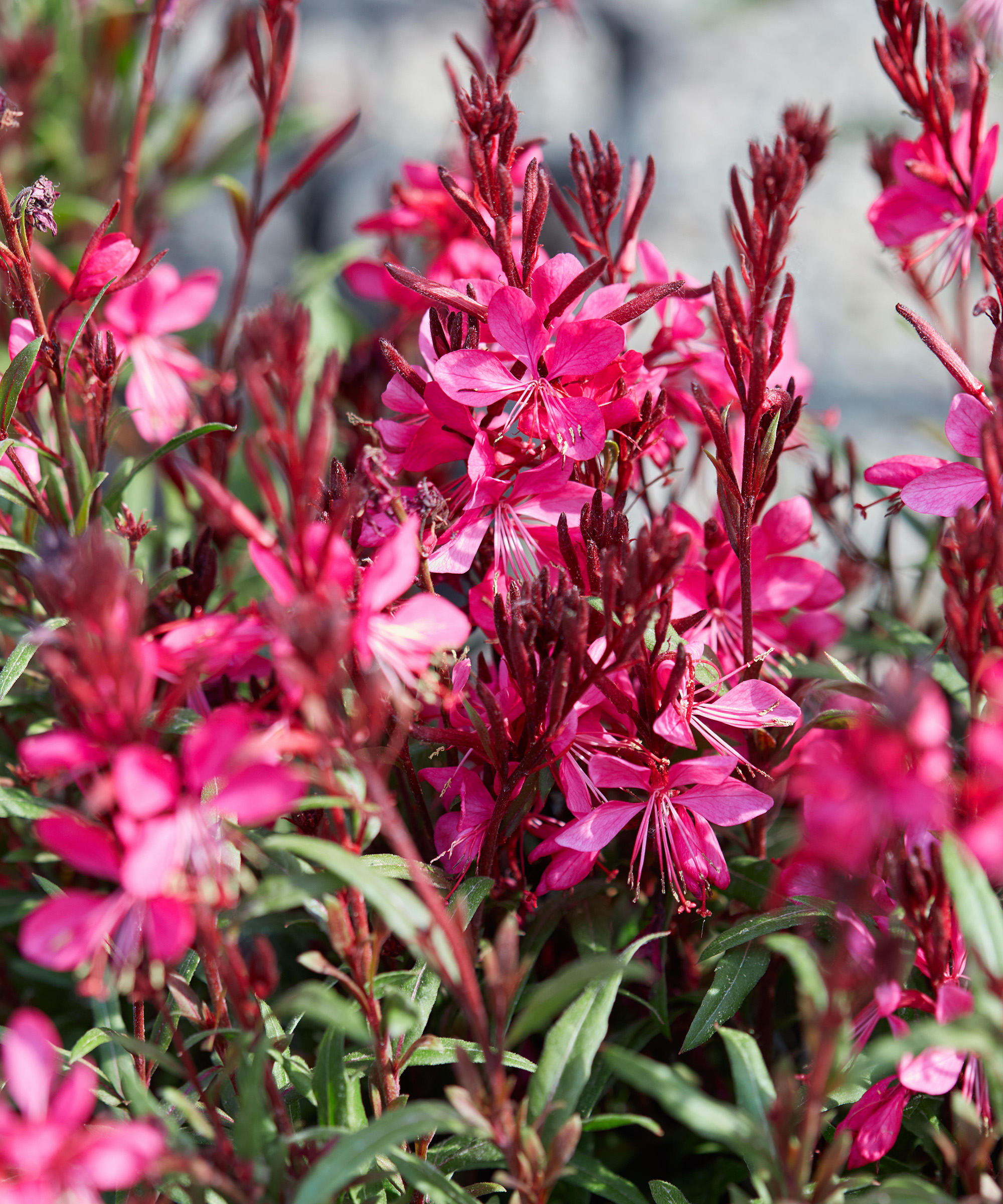
Gaura lindheimeri
- Hardiness: USDA 8-9 (UK H4)
- Height: 2ft (60cm)
- Spread: 2ft (60cm)
- Best for: Late summer
When they’re swaying in the breeze, the starry white or pink flowers carried on willowy stems look like a flight of butterflies. These flowering perennials are great for filling in gaps in a late summer garden and partner well with grasses.
Enjoy the red-tinted foliage through winter, then cut stems back to the ground in early spring. Replace plants every three years to keep the display looking healthy. They prefer a warm, sunny position but will tolerate some shade. ‘Whirling Butterfly’ is shorter than the straight species.
17. Thymus ‘Silver Posie'
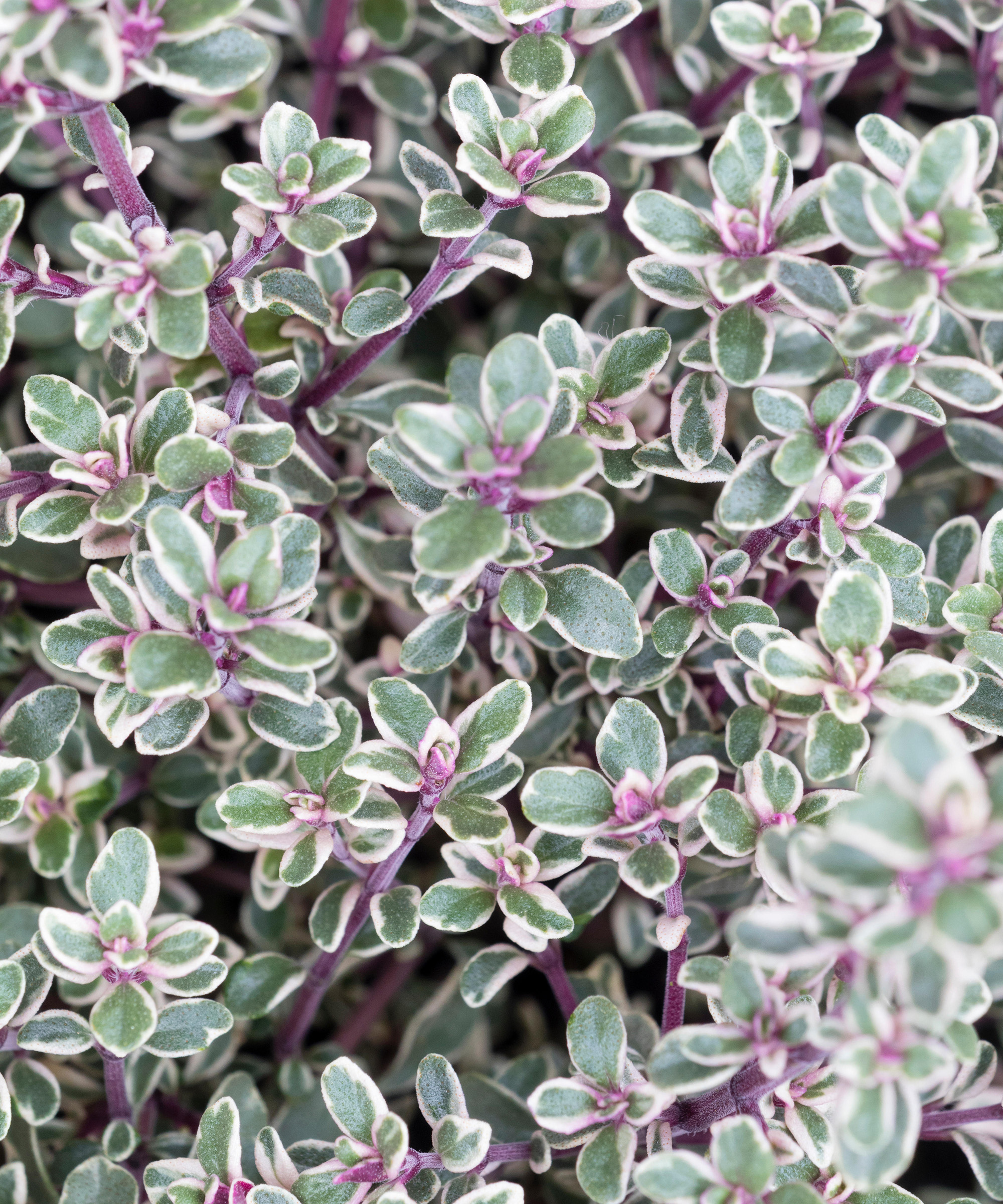
Thymus ‘Silver Posie’
- Hardiness: USDA 6-7 (UK H6)
- Height: 12in (30cm)
- Spread:12in (30cm)
- Best for: Balcony herb gardens
Compact perennial herbs like Oregano ‘Compactum’, Thymus ‘Silver Posie’ (above), Rosemary officinalis ‘Prostratus’ are excellent on balconies as herb garden ideas because they cope well with heat and drought – and they smell good too!
Bees love the flowers and regular trimming of the soft stems will keep plants bushy as well as give you herbs for cooking. Perennial herbs can be cut right down to the ground in late spring to rejuvenate them.
If your plot is in semi-shade try mint instead (there are lots of exciting varieties to choose from like chocolate, pineapple and banana).
18. Nasturtium
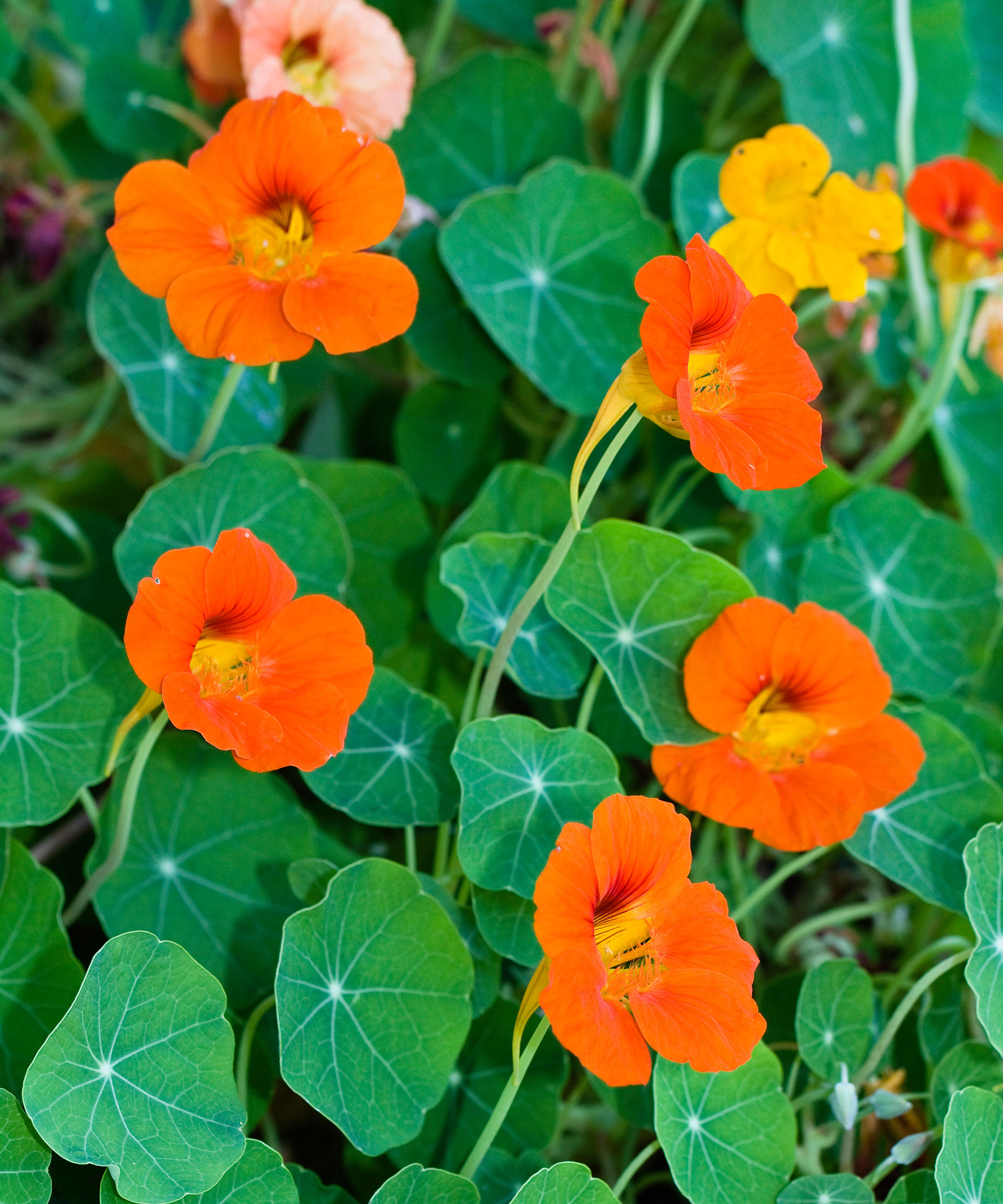
- Hardiness: USDA 9-10 (UK H3)
- Height: 6ft 6in (2m)
- Spread: 6ft 6in (2m)
- Best for: quick growing edible flowers
These half-hardy annuals are among the quickest and easiest annuals to grow. Sow the seeds into multipurpose compost outdoors on a balcony from late spring, when all risk of frost has passed.
If you want to skip the seed sowing, buy large plug plants in summer instead. Trailing types can cascade over the side of hanging basket ideas while bushy varieties like ‘Baby Deep Rose’ can go at the front of pots.
Nasturtiums also have edible flowers and they make wonderful decorations on cakes. Water them well while they are establishing and feed every 2-3 weeks with a high-potash fertilizer.
19. Magnolias
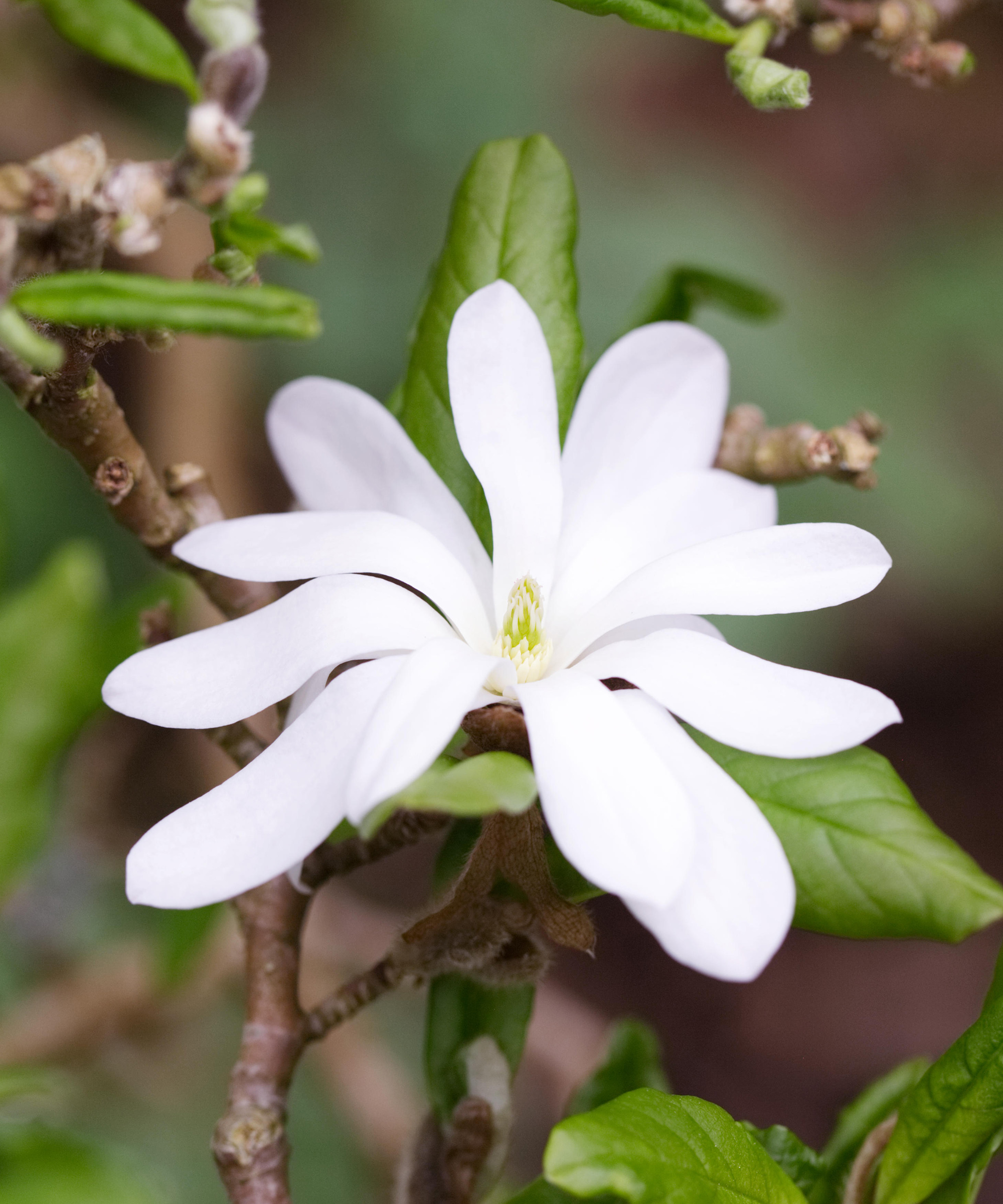
Magnolia stellata 'Water Lily'
- Hardiness: USDA 4-8 (UK H5)
- Height: 6ft 6in (2m)
- Spread: 9ft 8in (3m)
- Best for: potted trees
Some of the most magnificent magnolia trees are slow-growing enough to plant in containers. M.grandiflora is a popular choice with garden designers for its large evergreen leaves, which are bronze-colored on the underside.
If you have enough space, plant a row of four or five of them in a trough or planter against the balustrade; the foliage that sits above the railing will help to reduce wind flow and provide some garden privacy.
Magnolia stellata 'Water Lily' (above) has white scented flowers whilst Magnolia stellata ‘Susan’ has eye-catching deep purple blooms in the spring and makes a nice focal point. Full sun to partial shade is best. Prune after flowering to keep them compact.
20. Euonymus
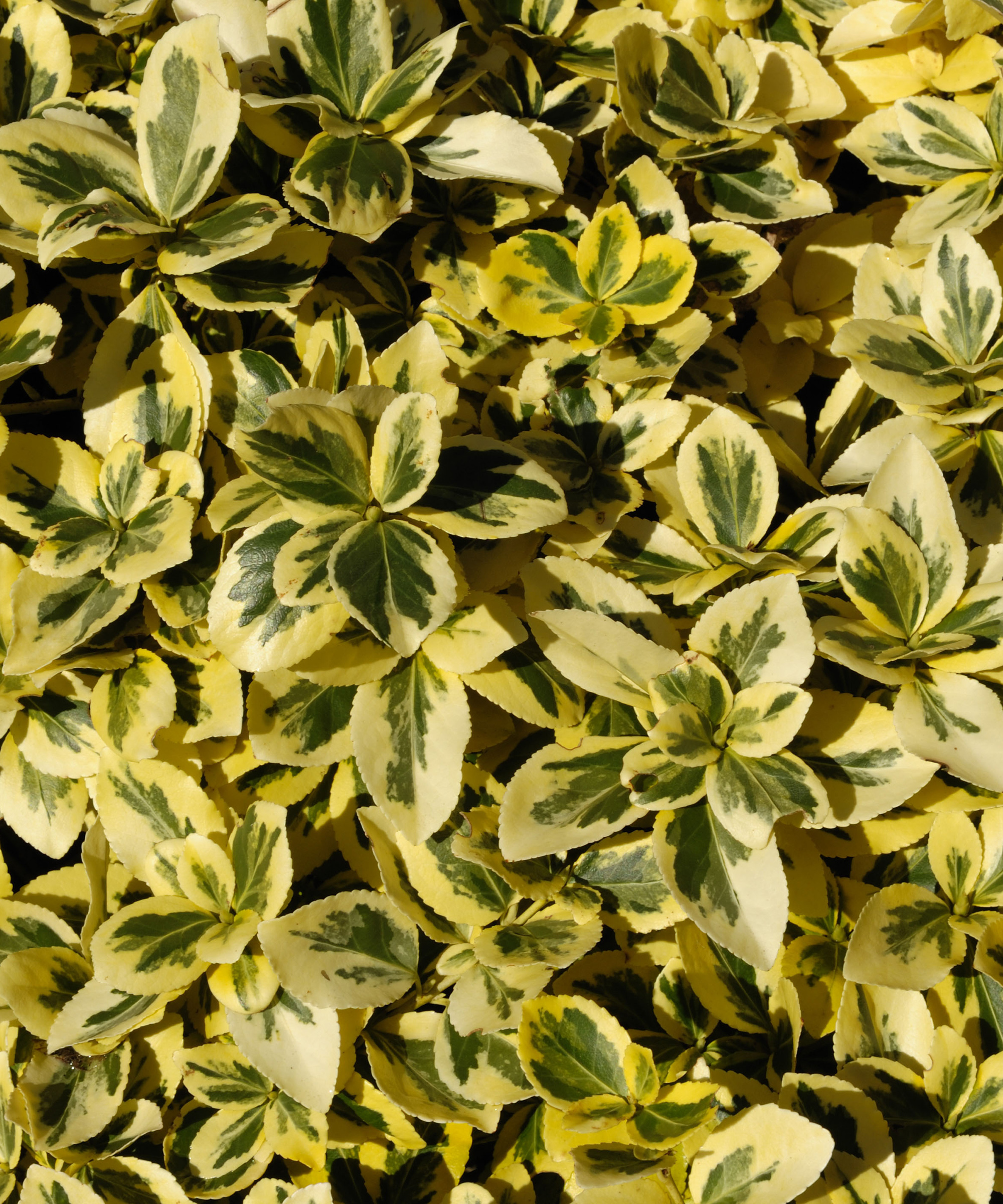
Euonymus japonica
- Hardiness: USDA 6-9 (UK H6)
- Height: 8ft (2.5m)
- Spread: 8ft (2.5m)
- Best for: year round interest
Robust and reliable, Euonymus japonica varieties are a safe choice for balcony plants. The upright ‘Green Spire’ looks stylish in wooden planters and has glossy green leaves all year round. It looks fabulous planted with the bonfire-red foliage of Nandina domestica.
It will do a good job of filtering the wind on balustrade balconies, providing some shelter for other plants behind. Euonymus likes full sun but is tolerant of full or partial shade. Euonymus planipes has a graceful vase shape and stunning autumn leaf color. This slow-growing tree can be grown in a large container and clipped into topiary shapes.
21. Phormium
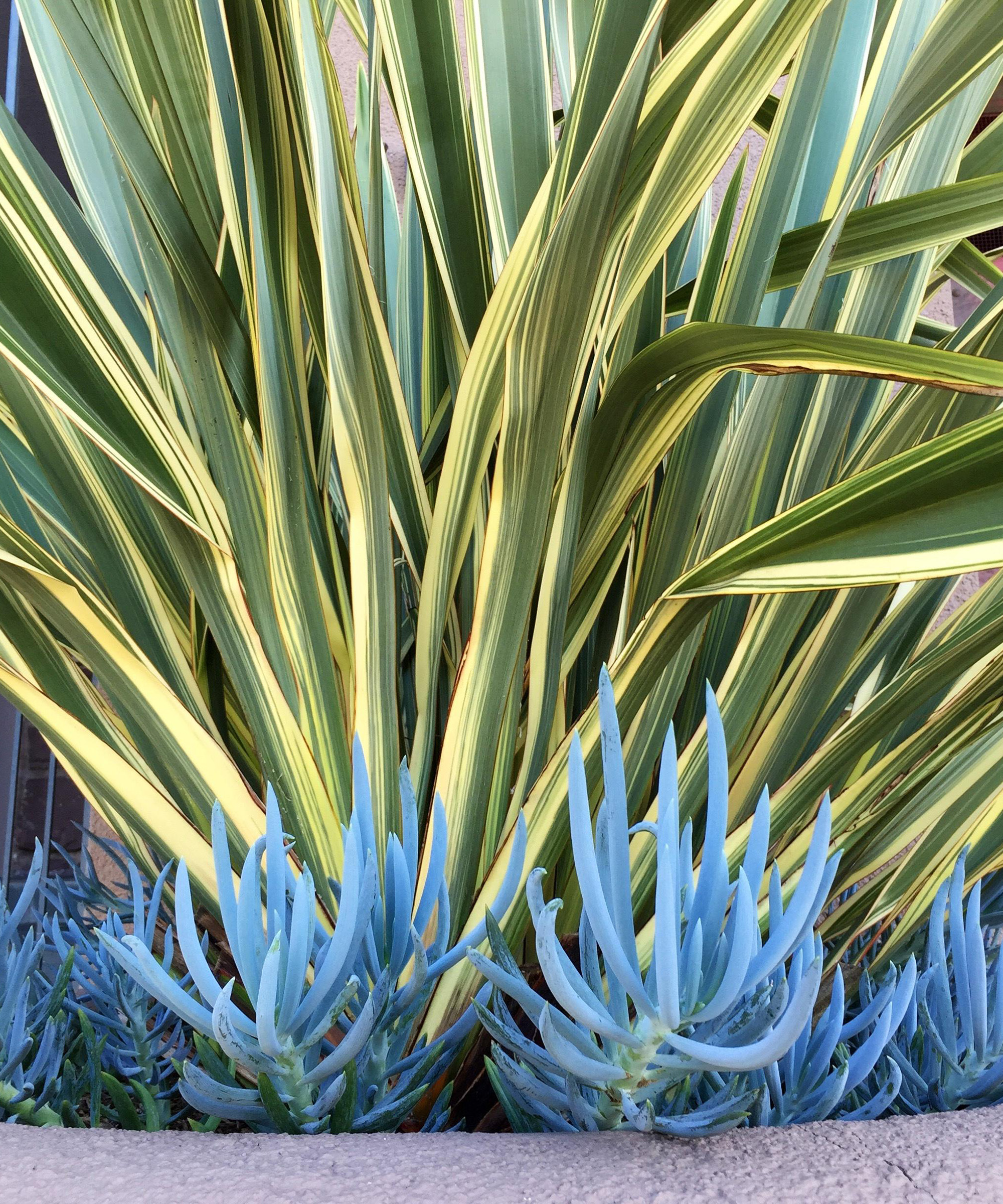
Phormium and Senecio
- Hardiness: USDA 8-9 (UK H4)
- Height: 3ft 2in-4ft 9in (1-1.5m)
- Spread: 3ft 2in-4ft 9in (1-1.5m)
- Best for: Screening
Tough and undemanding, phormium (otherwise known as New Zealand flax) will tolerate a range of conditions. They instantly create a focal point on a balcony, especially if planted in taller pots so their graceful, arching leaves can be better admired.
Remove any dead leaves in spring and add a sprinkling of slow-release fertilizer into the top layer of the compost. Keep well-watered in summer. Most are hardy but less so in pots. So if you live in a cold region then move pots close to a sheltered wall in winter if possible.
Pot these balcony plants on into larger containers if they’re starting to outgrow their current container; they can be divided in spring, too. Choose compact varieties such as ‘Maori Queen’ and ‘Jester’.
22. Nandina domestica
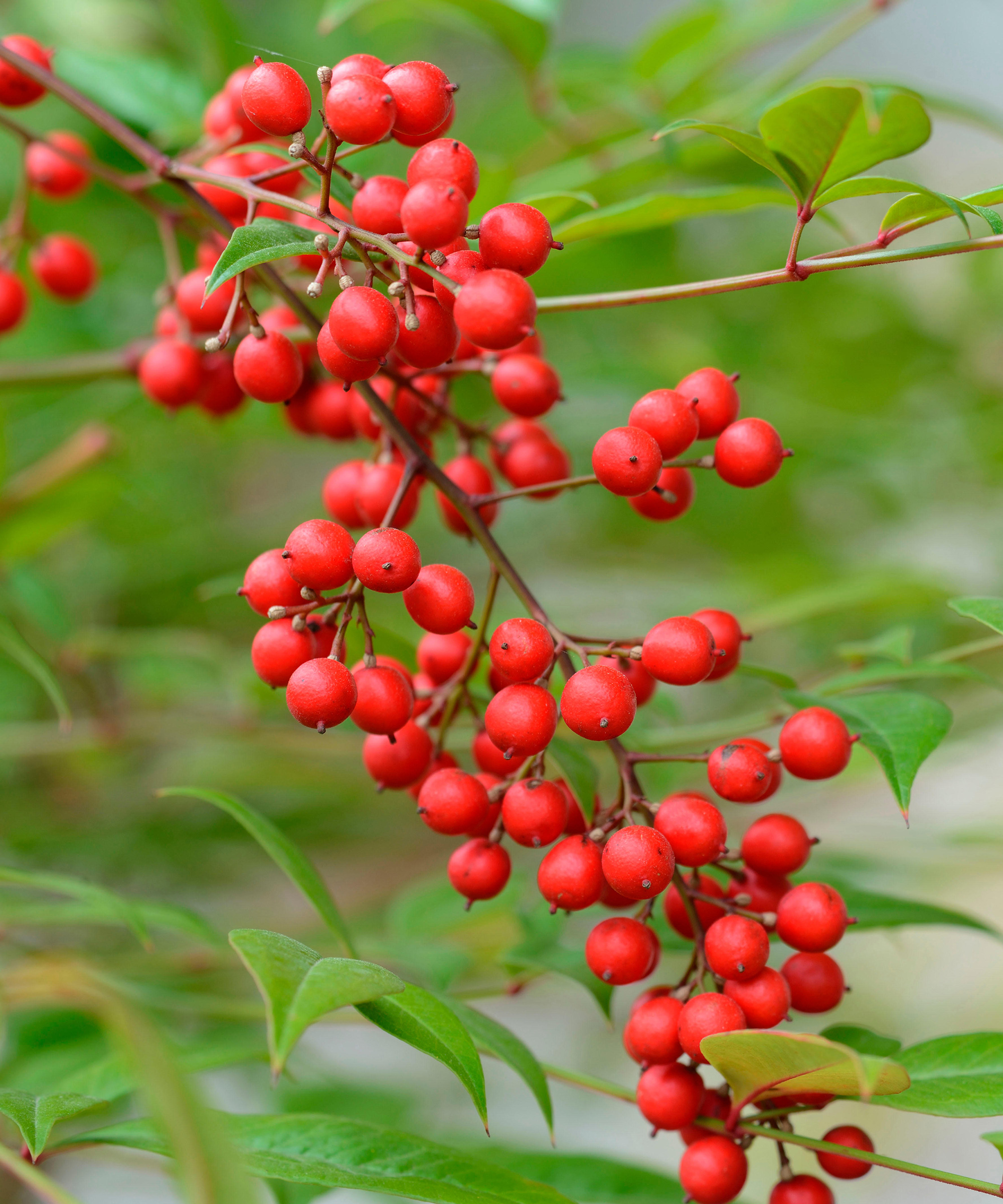
- Hardiness: USDA 7-8 (UK H5)
- Height: 4in-1.6ft (10-50cm)
- Spread: 4in-1.6ft (10-50cm)
- Best for: Screening
This low maintenance plant really earns its place on a balcony, offering bronze-tinted leaves in spring, pretty white flowers in summer, and bright red berries and fiery foliage in the fall.
Commonly known as heavenly bamboo, it isn’t actually a bamboo at all but has similar qualities with narrow evergreen foliage on arching stems that rustle in the wind. It suits a modern balcony but also fits in nicely with a jungle-style.
‘Firepower’ is low-growing (1ft 4in/45cm) and partners well with grasses, pines and evergreens. ‘Obsessed’ is a taller variety at 2ft 2in (70cm), good for creating garden screening. Use ericaceous compost and keep plants watered regularly.
23. Bamboo
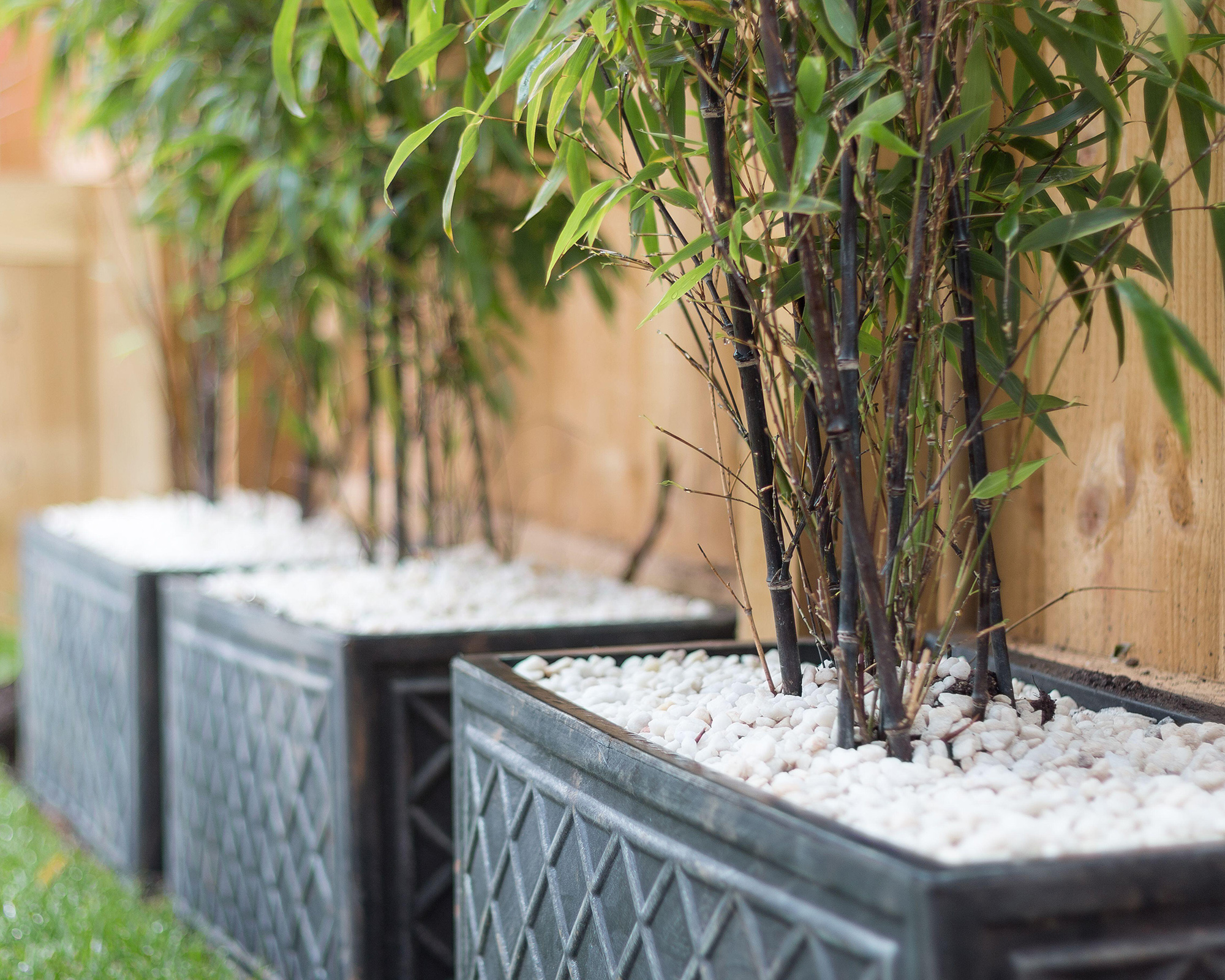
- Hardiness: USDA 7-8 (H5)
- Height: 6ft (2m)
- Spread: 3ft (1m)
- Best for: Wind filtering
Known for their fantastic wind-filtering and screen abilities, bamboo is useful on a balcony. Grow it in pots for a brilliant way to control their growth but choose only the clumping varieties, as these will expand less in their pots.
A 15in (40cm) wide pot is the smallest reasonable container size but be prepared to move the bamboo onto a bigger pot size or divide it every few years to keep it healthy.
Fargesia ‘Lava’ and ‘Simba’ are compact enough for pots. Use a John Innes No3 compost and add in slow-release fertilizer granules.
What are the best flowers for a balcony?
Annuals and bedding plants in spring and summer are great for creating instant colorful displays on your balcony – petunias, pelargonium and most summer bulbs like sunny conditions while begonia and fuchsia are brilliant for shady spots.
Perennial flowering plants will come back year after year but use a compost that’s suitable for permanent plantings – John Innes no3 is the one to go for. Compact hydrangeas like ‘Little Lime’ offer fantastic flower power on a shady balcony, while Delosperma ‘Hot pink’ and Californian poppies cope with wind as hot sun.
Always keep a base of low maintenance evergreen shrubs like hebes and Euonymus as this will give you color all year round. But use seasonal flower additions to give plenty of variety to your balcony plants throughout the year.
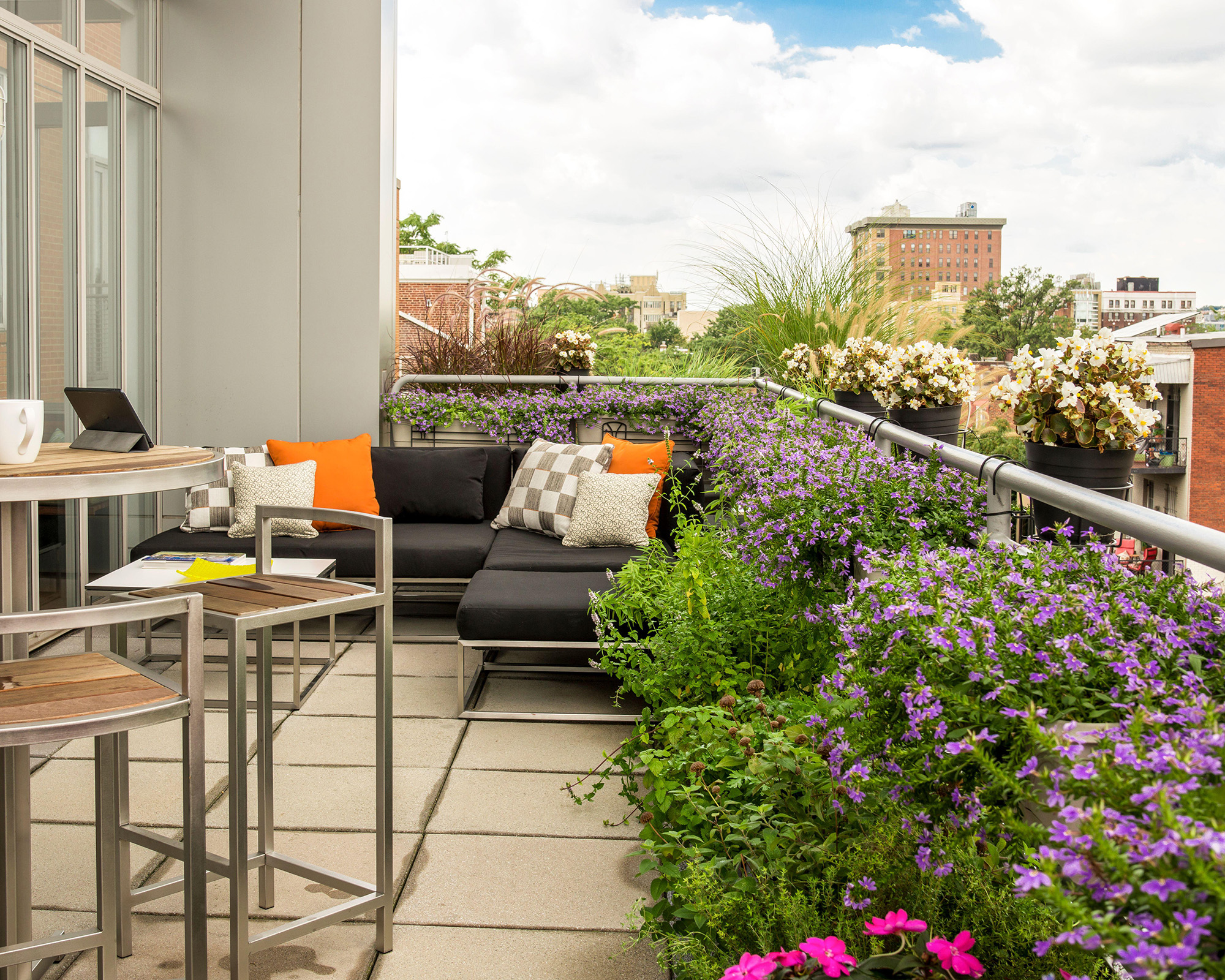
What plants can grow on a windy balcony?
Coastal plants which are used to sea breezes will be good choices for windy balcony plants. Wind can also be quite drying so drought tolerant plants are also a sensible choice.
Grasses look lovely planted with sea holly. Sea thrift, hebes, dwarf pines and campanula will also all thrive in windy conditions.
How many plants should I have on my balcony?
Having lots of different balcony plants and pots will make a balcony look cluttered. If you can, try to limit your plant choices to just two or three varieties, planting small groups of each type to create a stylish, calm feel.
Using high, shallow planters or window boxes attached to the railing will bring plants up to eye level, as well as leave enough room for some compact patio furniture ideas such as a bistro table and chairs.
Try to connect the outdoor space with the inside by choosing linking colors – a wall color could match the color of the plant pots, for example. Greenery on a small balcony will draw the eye, making the inside of your home seem bigger.

Working at a garden center when she was 23, Sally realised straight away the therapeutic power of being around greenery and nurturing plants. She's horticulturally trained to degree level and has worked on gardening magazines for over a decade. Sally now gardens in Bournemouth, UK, zone 8a (H5).
